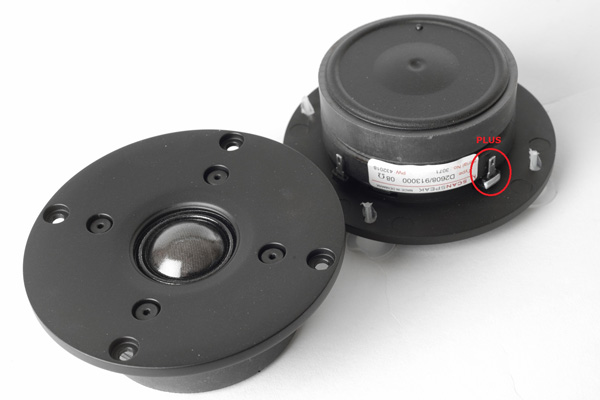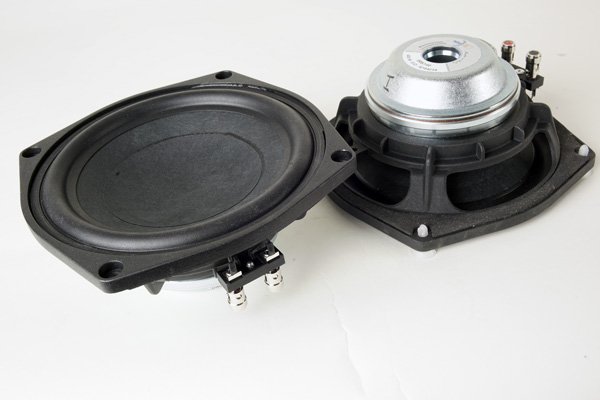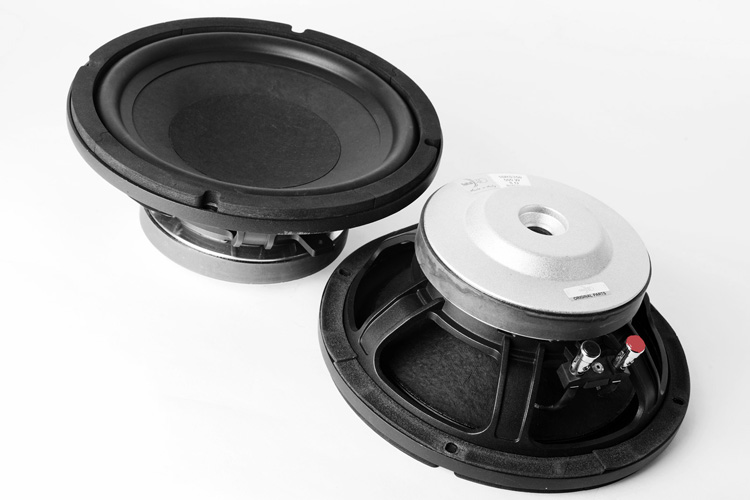Faital 3WC-10
Copyright 2021-22 © Troels Gravesen
Go to on this page:
DRIVERS
CROSSOVER
CABINET
WORKSHOP PICS
MEASUREMENTS
SPEAKER-KIT
CROSSOVER LAYOUT Beryllium dome version
There have been requests for a smaller Faital 3WC and having had good
results with the Faital 10RS350 bass driver in my SBA-741/bass-module,
this driver was an obvious candidate for a Faital 3WC-10 version. In
fact, the 10RS350 is one of the very, very few 10" PA bass drivers suitable
for hifi bass. Some PA driver manufacturers do not even make 10" drivers
as 12" seems a not unusual size for midrange drivers in PA world, and if
you mean bass, then 15-21".
Based on simulation, the 10RS350 will make F3 = 38 Hz from 45 litres and
assuming 10% increase in volume from damping materials we should end up
at F3 = 36 Hz, more than enough for our purpose. Impedance measurement
confirm this. With an inherent ~92 dB sensitivity
(infinite baffle), we might tune the system sensitivity to around ~91
dB with a healthy 8 Ohms impedance - and some room-gain, the latter the
inevitable choice to be made. Interestingly we may get ~91 dB from
the 10", ~93 dB from the 12" and ~95-96 dB from the 15" version with
similar F3 levels. As stated many times before, if we want decent bass
from small enclosures, we have to sacrifice something, in this case
efficiency. If we wanted a 10" to make 95 dB with some decent bass, we
need huge cabinets - and another driver - or two 10RS350 bass drivers in
parallel. Actually the midrange would cope with this, but we might
need another tweeter with higher sensitivity and accept lower impedance.
Some other time...or maybe not.
There was no doubt in my mind of using the same drivers for midrange and
tweeter as for the basic Faital-3WC-12. The Faital 6RS140 and ScanSpeak
D2608/913000. These drivers deliver excellent performance and are very
competitive. All drivers will set you back some 520 EUR. How about that?
I have a friend always being the first to listen to any new construction
- at the initial stage of crossover development. We don't necessarily
agree on all sonic issues, but that's a good thing. I need various input
to balance my own preferences. Fine-tuning can mean a lot to how the
finished speaker will perform. Anyway, after five minutes he asked when
the pair would be for sale - and at what price. Well, he doesn't use to
respond that way! I couldn't tell the price, because the kit calculation
was far from ready and I couldn't make up my mind on how much I would
charge for the woodwork, but apparently the expected price point would
suit his budget and also the size would suit his wife! And that's an
important thing. Another important thing was that the speaker could be
driven to thunderous levels from my 32 wpc EAR-861 - and at the same
time deliver surprisingly deep bass for the size. On paper this speaker
has an F3 some 10 Hz lower than the 12" version - at the expense of
sensitivity, but the lower sensitivity was not a problem for my 32
watts, not at all.
Apart from the deep bass this speaker delivers phenomenal midrange
transparency and a smooth transition to the treble range. If you can
accept the look of PA drivers you get something equivalent to seriously
expensive "hifi" drivers for less than half the price. And having the
tweeter below the midrange driver this speaker certainly qualifies for a
front grill without compromising sound noticeable. Even higher WAF!
December 2022:
Today is ~1½ year after launch, and the Faital-10 kit has become the
best selling kit in 2022. I hadn't seen this coming, but apparently the
Faital-10 hits the right balance between ease of construction, size and
cost - not to forget exceptional sound.
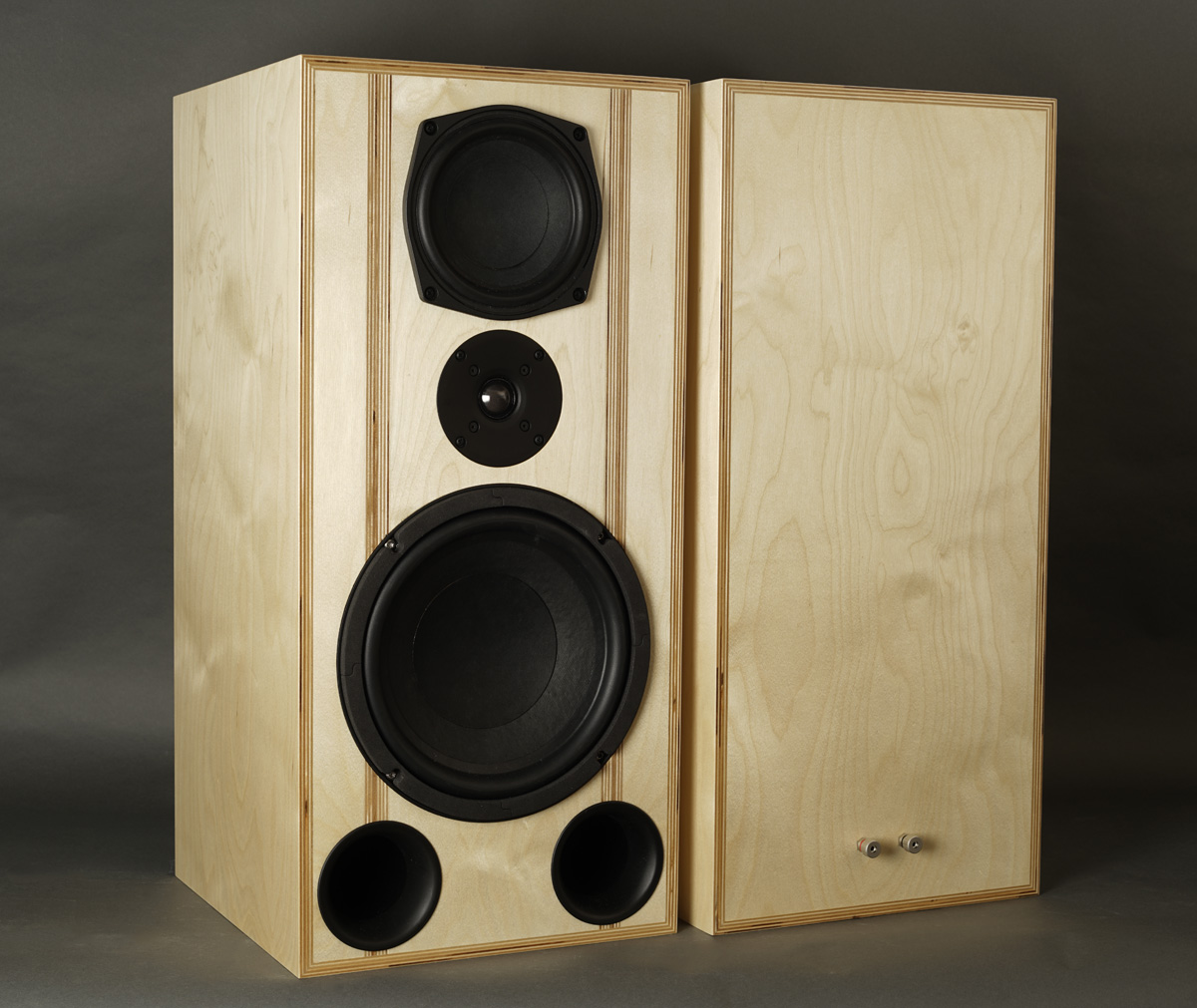
Setting up the finished speakers in our living room made me finally
realise the magnificent combination of bass and mid-driver. Dynamic and
with a degree of 3-dimensionality rivaling whatever speaker I have ever
made, regardless of brand and costs. I know this is big words, but I'll
stick my neck out for any comparison on transparency and
3-dimensionality. Maybe cone material of said drivers - or cone shape
with inverted domes. I don't know. It just works. Horizontal dispersion
is excellent with some +/- 1 dB all the way to 12-14 kHz at a window +/-
30 deg.
The midrange driver has a very low-order high-pass filter with a rather
small resistor bypassing the series capacitors. Equally well works the
midrange driver with the 9130 tweeter. R2 has a rather high value
leaving a shallow roll-off of the high-pass section. It really leaves
the question of making a double-bass floor-stander, but again, sales
potential would probably be limited. Of any mid-sized 3-way classic,
this is the best I've made.

I've had the Metheny/Scofield CD since its release in '94, but never
really enjoyed it much, so I couldn't resist the temptation to acquire
the vinyl edition once reviewed at
Analog Planet. Being a double LP with only three tracks in each
side, the vinyl caught my attention again with a presence quality that
the CD never really could manage.
I've been digging the Danish Vestbo Trio lately with the Gentlemen
LP being my first acquisition. I've played this LP over and over
again. A friend gave me the 2nd LP, While You Were Gone
and finally the LP, Doppler Effect, a live recording with local
guitar guru Uffe Steen. It goes without saying the Faital-3WC-10 let me
enjoy these recording to the fullest, from the quietest to the almost
eardrum piercing guitar solos.
Only quibble I can up with on the Vestbo records is the miserable info
on covers. So, search the web for more info.
Basics:
3-driver speaker.
Dimensions: 32 x 34 x 68 cm, WxDxH.
System sensitivity: 91 dB/2.8V/1 meter.
Impedance: 4-8 Ohms, minimum 4 Ohms @ 100 Hz.
Power requirement: 20+ watts/channel. Obviously this depends on size of
your room and how loud you play.
Power handling: 300 watts (based on bass driver specs).
Please
also read:
http://www.troelsgravesen.dk/power-handling.htm,
and remember any burned driver is a misused driver.
Useful links (Please read before writing!):
http://www.troelsgravesen.dk/tips.htm
http://www.troelsgravesen.dk/crossovers.htm
http://www.troelsgravesen.dk/LCR-RC.htm
http://www.troelsgravesen.dk/Inverted-Polarity.htm
FAQ (Please read before writing!):
You cannot change cabinet front panel dimensions and drivers' placement
without needing a new crossover - and I cannot help.
You cannot use any other drivers with the crossover specified.
http://www.troelsgravesen.dk/crossovers.htm
http://www.troelsgravesen.dk/choices.htm
Read the excellent review by Dickason in AudioExpress.
Download specs here: D2608/913000 6RS140-8 10RS350
All drivers 8 Ohms.
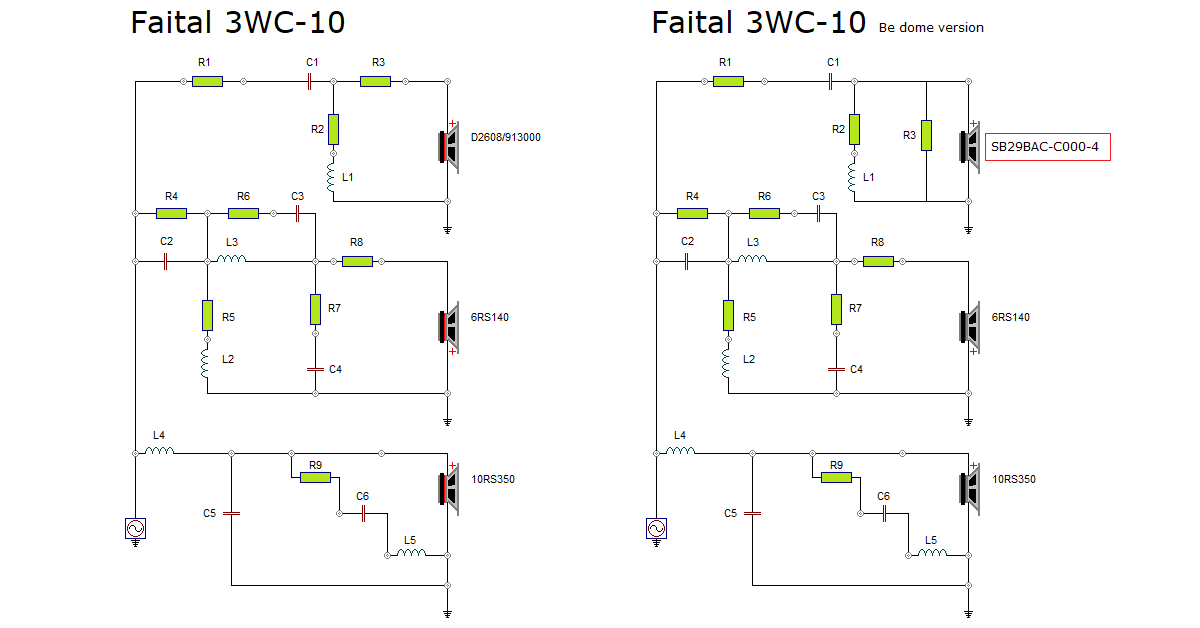
R9/C6/L5 flattens the upper bass impedance peak and allows the low-pass filter to work properly. R6/C3 for midrange shapes the upper roll-off, this together with R7/C4. R2/L1 have rather large values giving the 9130 tweeter an almost 1st order roll-off and blending smoothly to the midrange.
The Be dome versions mimics the high-pass filter of the D2608/913000 tweeter as close as possible. Having a lower impedance we need a larger C1 - costly, but so are the Be domes.
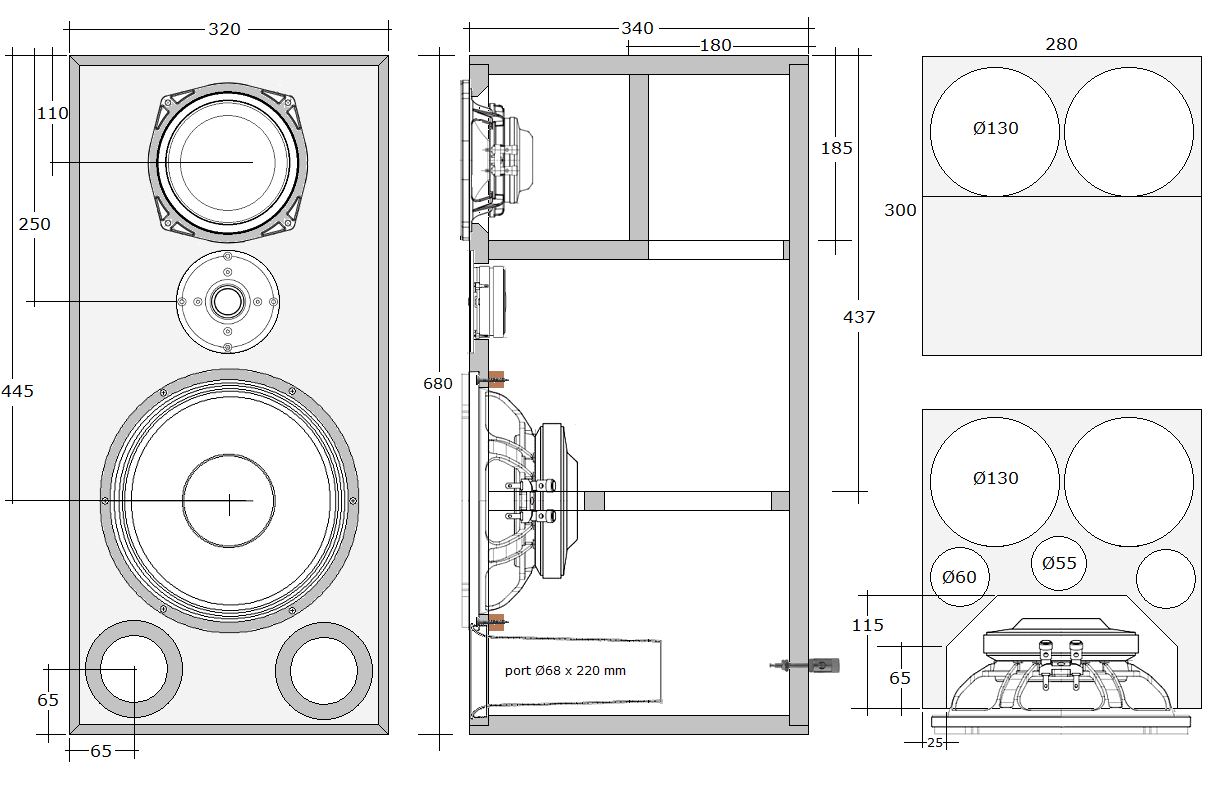
I decided to route for the bass driver to a depth of 10 mm, depth of basket rim, leaving only 10 mm for the screws. Make a ring of plywood, e.g. 15 mm and glue to front panel - or glue blocks of plywood behind screw holes. This will ensure proper material for the mounting screws (brown markings).
Cabinet kits available from EBEL Holztechnik.
Time-alignment:
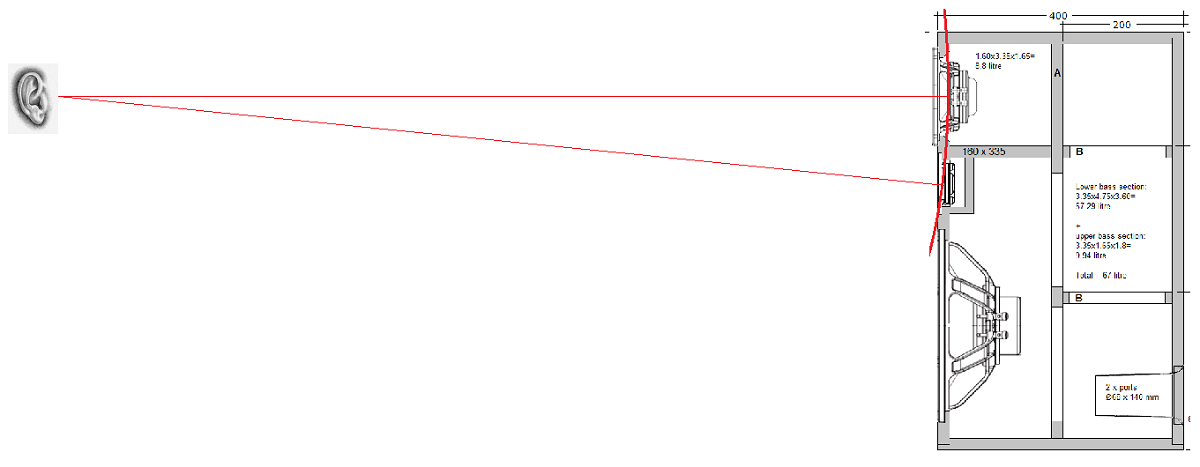
The reason for having the midrange driver not flush-mounted and on top
of the tweeter is to take advantage of the above alignment, assuming
listening height on midrange on-axis. This way we can avoid a stepped
baffle making an overall easier cabinet construction.
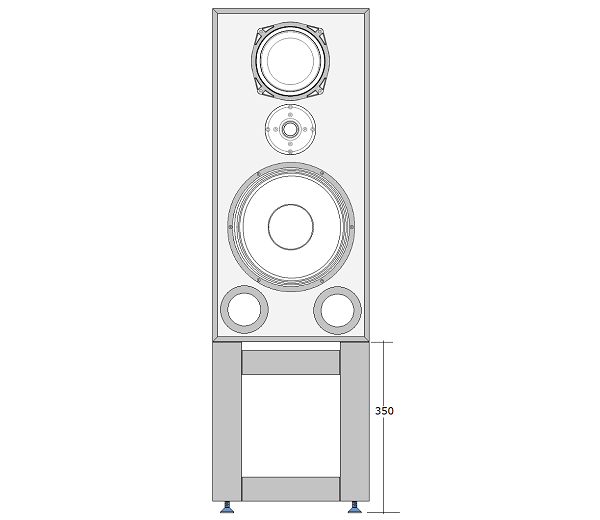
The speakers need some stands to have the midrange at ear height.
For my listening chair - and ear height, some 35 cm. Adjust height to
your conditions.
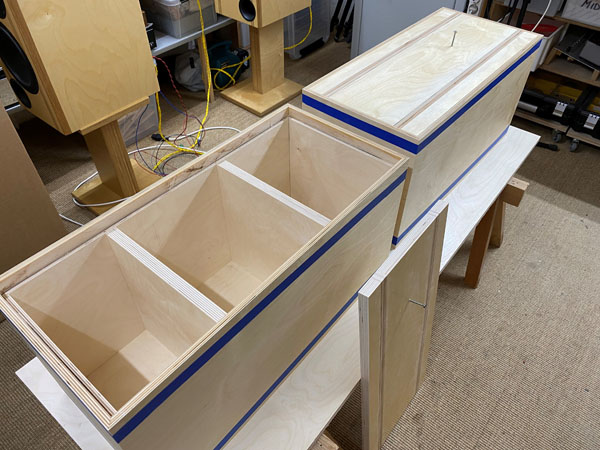
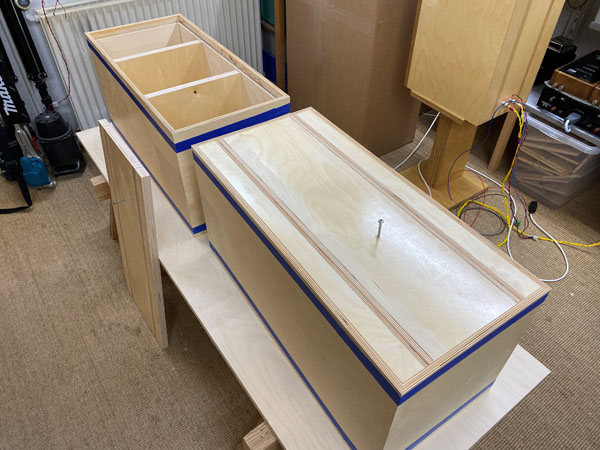
These cabs are almost as simple as can be for a 3-way classic.
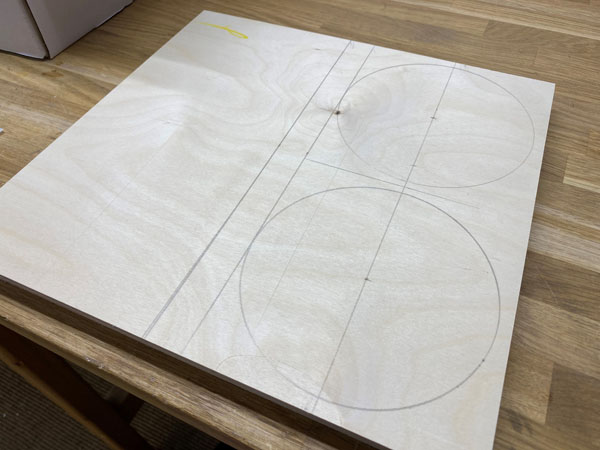
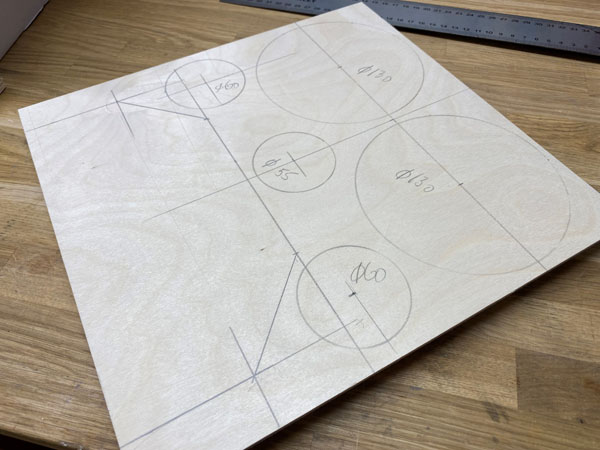
Making of the braces. Actually I made the small hole in the middle 60 mm also - as there was room for it.
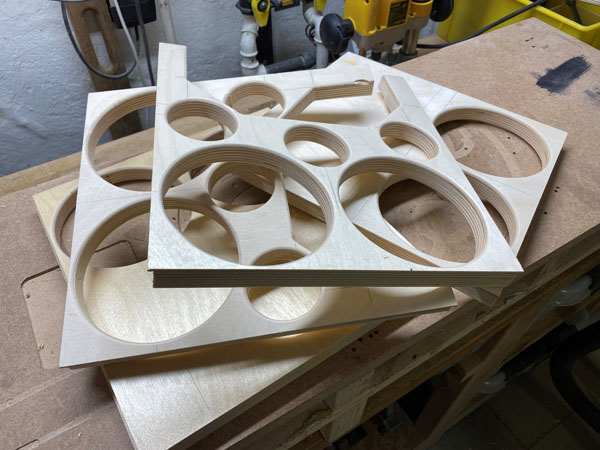
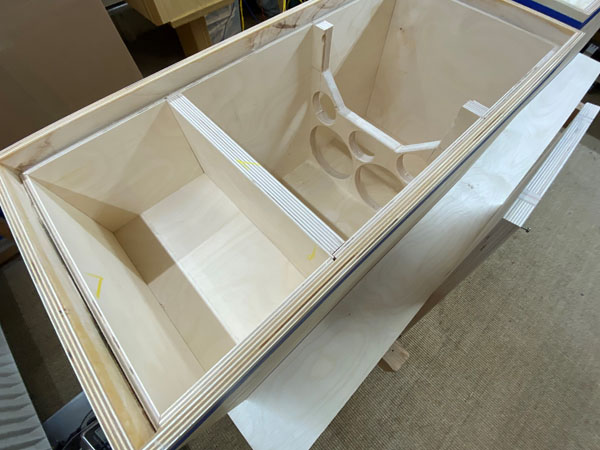
Braces inserted and midrange rear panel in place. Now ready for damping material.
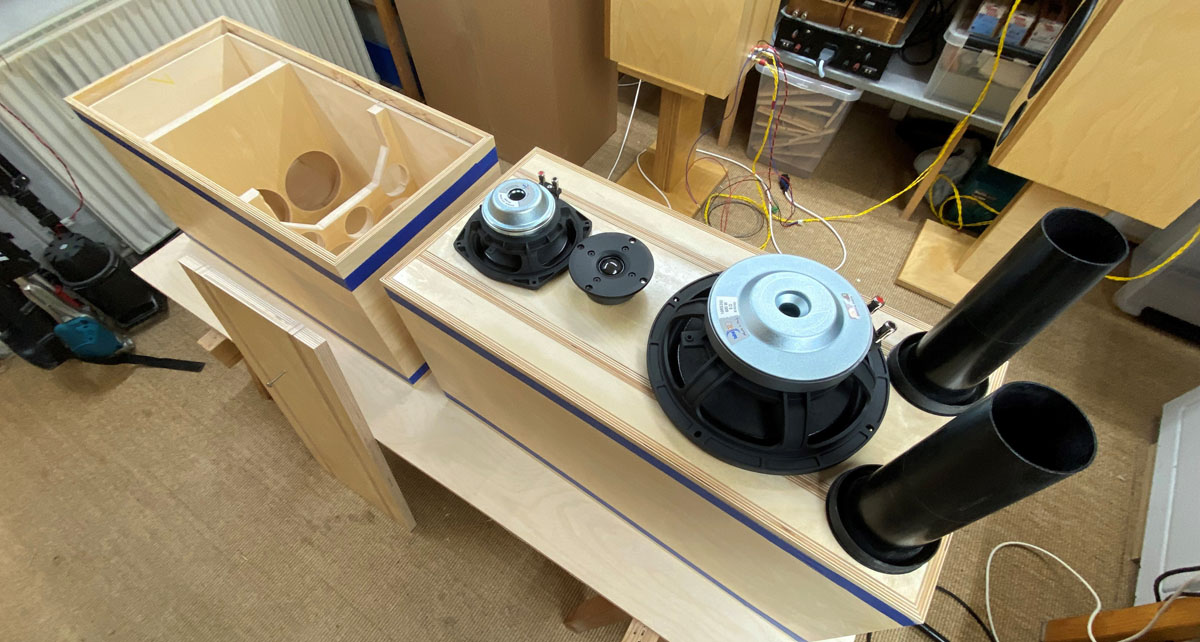
Is there room for all on the front panel? There is.
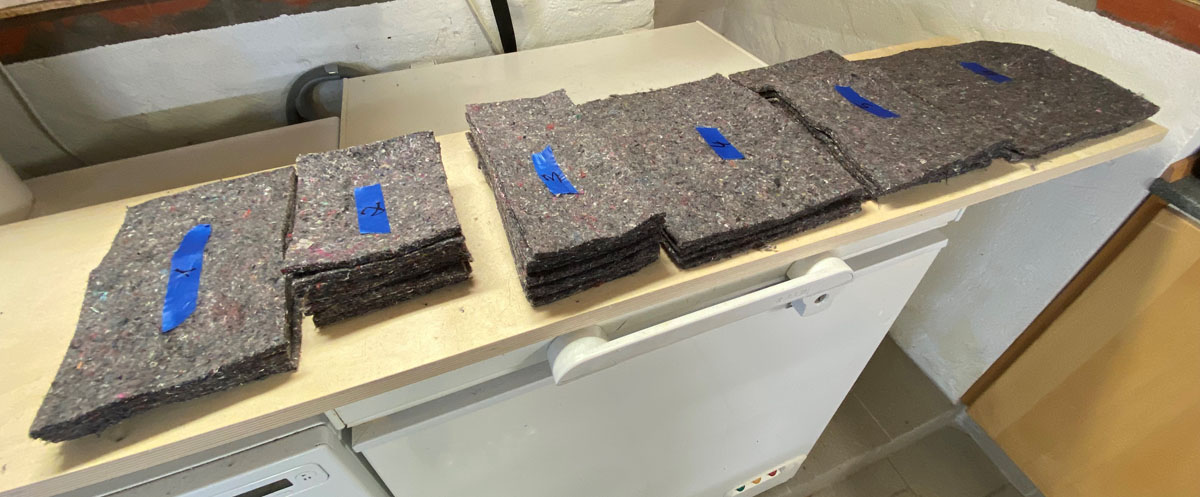
All damping sheets cut.
I use vinyl glue for the felt.


Felt damping almost finished.
No damping on the rear panel behind the bass driver yet. Here the crossovers will be attached and covered with acoustilux.
In addition to the felt, the midrange cabinet to be filled with 100 grams sheeps wool.
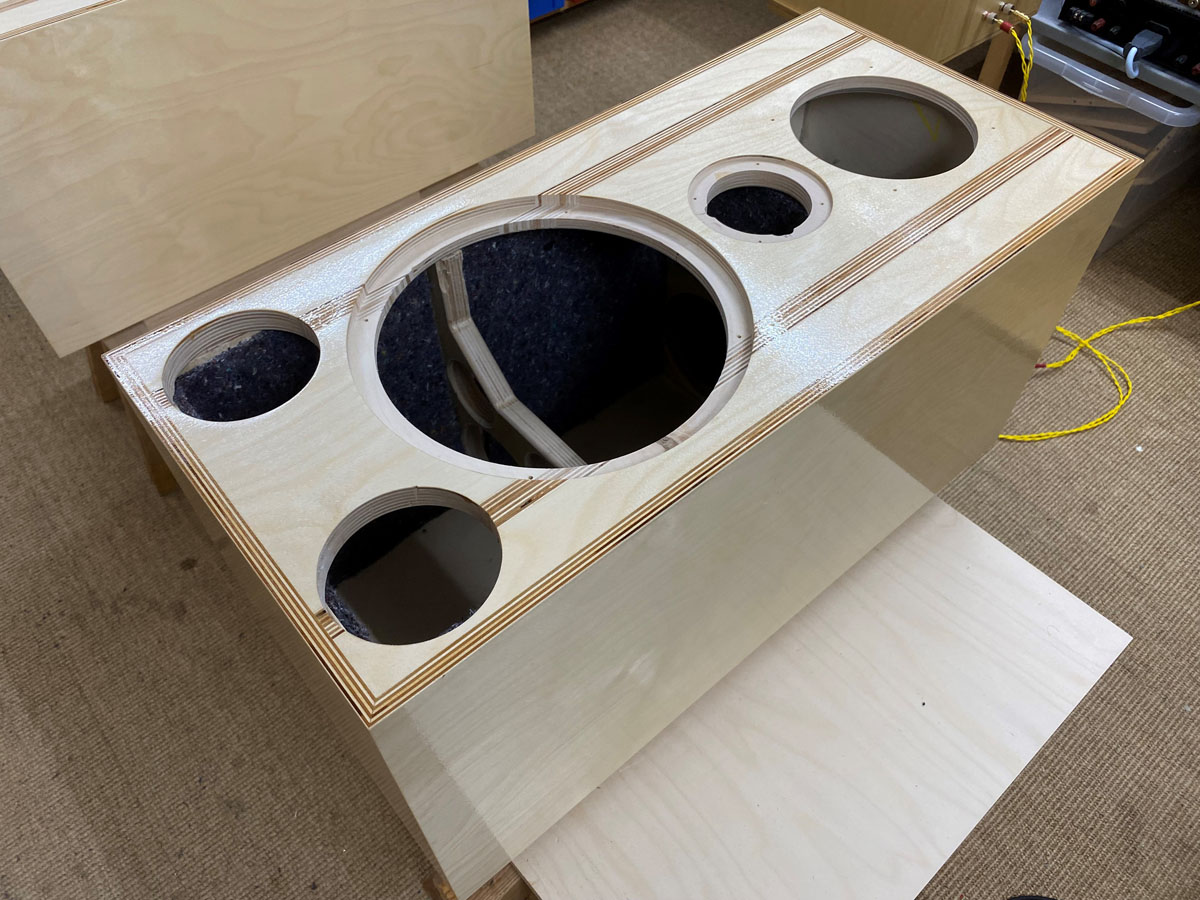
Fully assembled and 1st coat of lacquer.
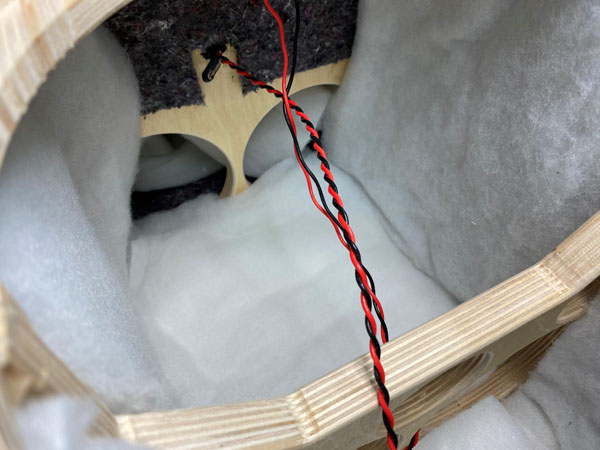
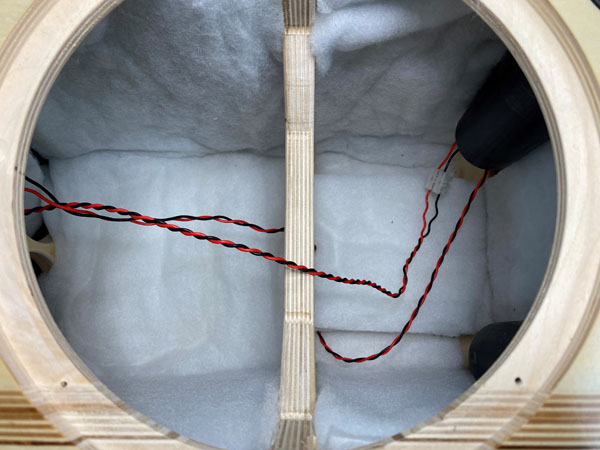
Acoustilux cutting plan for two cabinets:
4 pcs 23 x 50 cm for upper sides in bass section. Start from front panel and let it cover the rear panel twice.
6 pcs 13 x 50 cm for lower sides in bass section - and between ports. Start from front panel and let it cover the rear panel twice.
2 pcs 25 x 50 cm for upper part behind midrange driver. Just stuff the cavity loosely.
The above will produce double layer on rear panel upon the crossover sections. See crossover layout below.
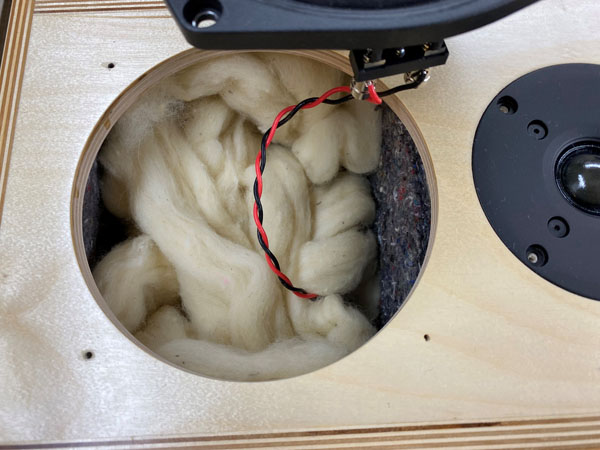
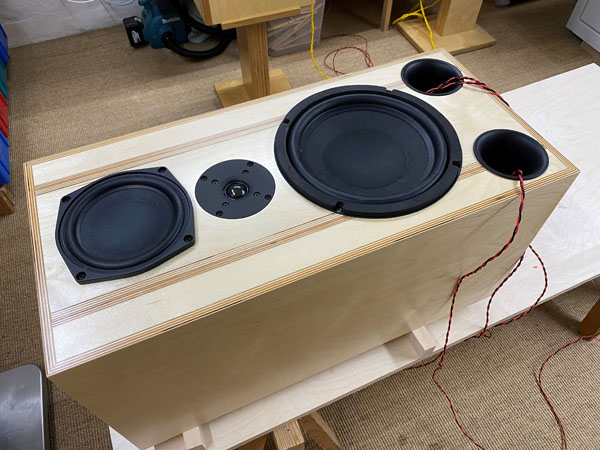
Weigh out 100 grams of sheeps wool for midrange cabinet. To the right, all drivers mounted with leads through the ports, ready for crossover construction.
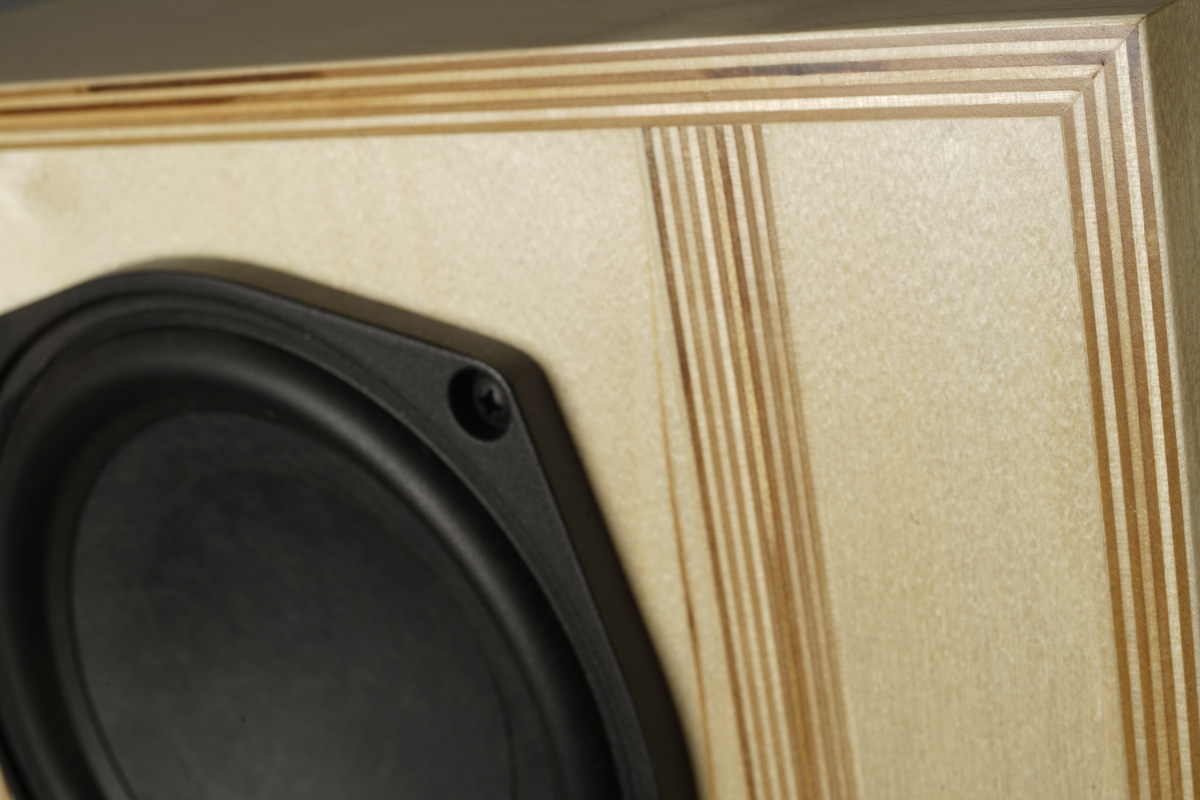
A few comments on
MEASUREMENTS before you start interpreting the readings below.
First of all, if we think measurements will
tell us how a speaker sounds, we're wrong. The perception of sound is
way too subjective to be reflected in any measurements we can perform. A
loudspeaker system is meant to give us a satisfying idea of an acoustic
event and for some people a pair of 5 USD ear-plugs are enough, others
spend 200 kUSD on a truly full-range pair of speakers - and the latter
may not be happier than the former.
Measurements may give us an idea of tonal balance of a system, i.e. too
much or too little energy in certain areas, although dispersion
characteristics play a vital role here. A two-way 7+1 and a three-way
7+4+1 may display similar horizontal dispersion, yet sound very
different. Measurements may tell us about bass extension if far-field
measurements are merged with near-field measurements. In addition to
this, ports may contribute to bass extension. Most of we diy'ers do not
have access to an anechoic room for full-range measurements from
20-20000 Hz.
What cannot be seen is what kind of bass performance we get in a given
room. Bass performance is highly dependent on in-room placement of your
speaker and the same speaker can be boomy in one place and lean in
another. Actual SPL level at 1 meter distance and 2.8V input is useful
for en estimate of system sensitivity and combined with the impedance
profile may give an idea of how powerful an amplifier is needed to drive
the speaker to adequate levels.
What measurements do not tell is the very sound of the speaker unless
displaying serious linear distortion. The level of transparency, the
ability to resolve micro-details, the "speed" of the bass, etc., cannot
be derived from these data. Distortion measurements rarely tell much
unless seriously bad, and most modern drivers display low distortion
within their specified operating range.
Many people put way too much into these graphs and my comments here are
only meant as warning against over-interpretation. There are more to
good sound than what can be extracted from a few graphs. Every graph
needs interpretation in terms of what it means sonically and how it
impacts our choice of mating drivers, cabinet and crossover design.
What measurements certainly do not tell is the sonic signature of the
speaker, because speaker cones made from polypropylene, aluminum,
Kevlar, paper, glass fiber, carbon fiber, magnesium, ceramics or even
diamonds all have their way of adding spices to the stew. Nor do
measurements tell what impact the quality of the crossover components
add to the sound, from state of the art components to the cheapest of
coils and caps, they all measure the same if values are correct, yet
sound very different.
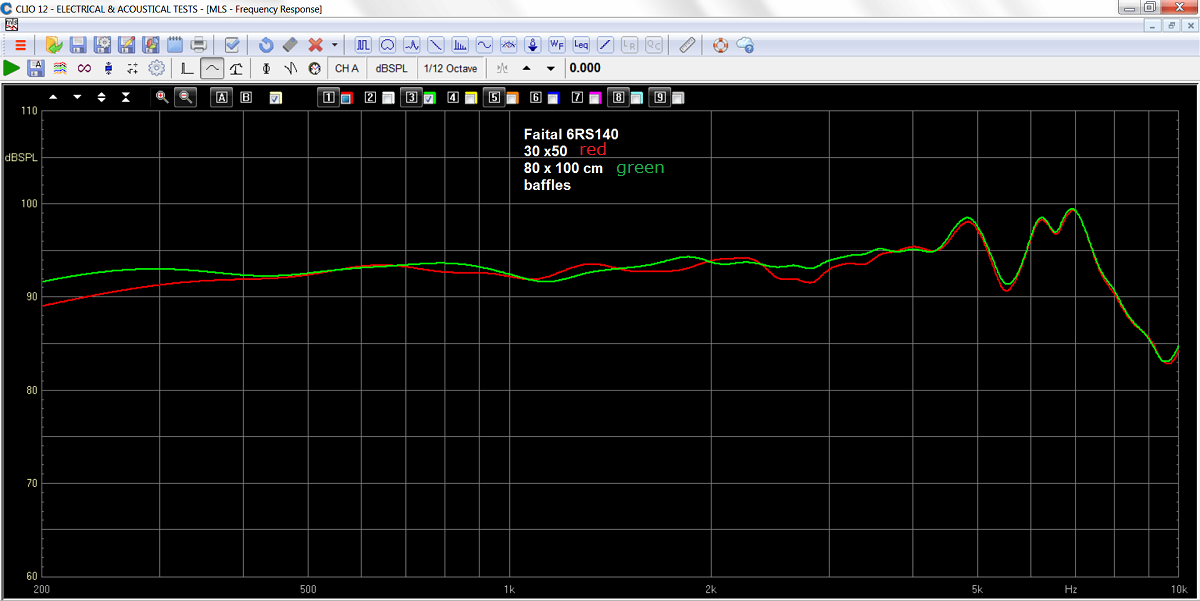
Frequency response of 6RS140 midrange driver on "infinite baffle".
Smooth in the critical area around 1 kHz.
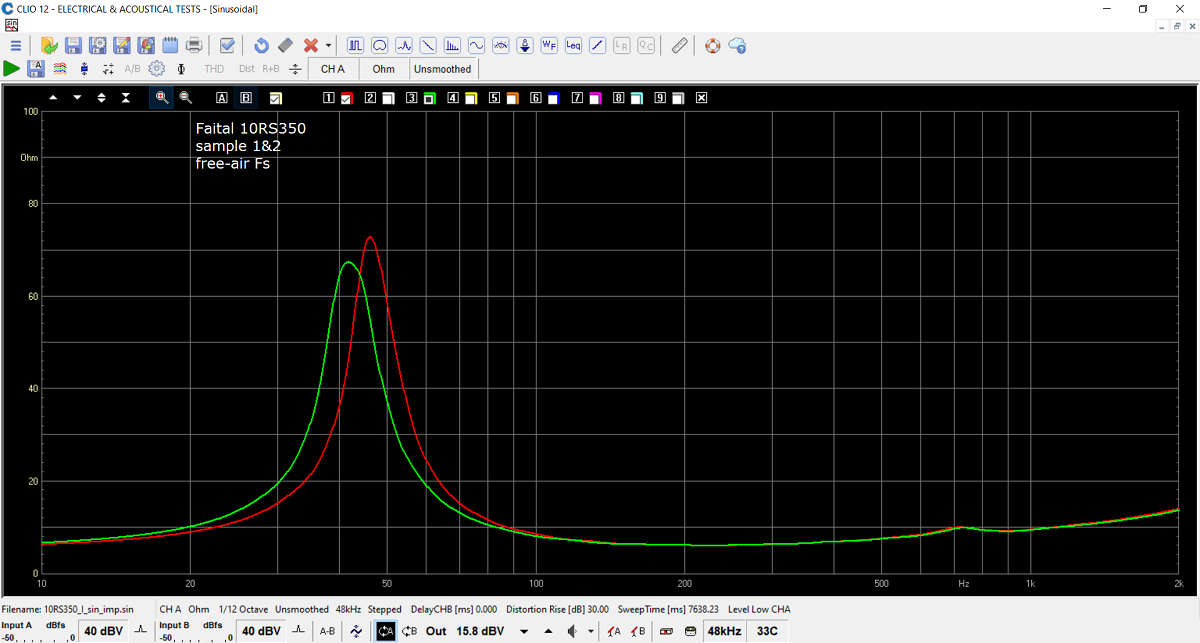
10RS350 bass impedance of two drivers, measured in free air.
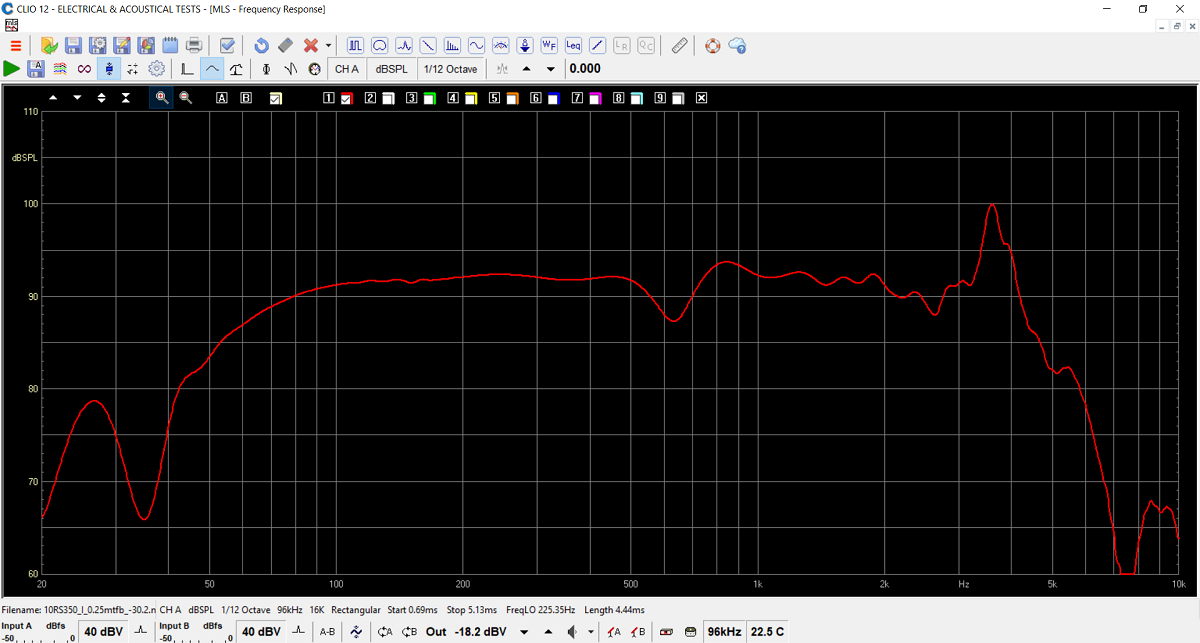
Frequency response of 10RS350 driver in actual cabinet, merged with near-field response @ 200 Hz. Generally a fine response, a little wrinkle around 600-800 Hz (most likely rubber surround resonance) and a peak at ~4 kHz, which is of no concern as we will have a point of crossover around 400 Hz between bass and midrange. The dip at ~35 Hz indicates the port tuning.
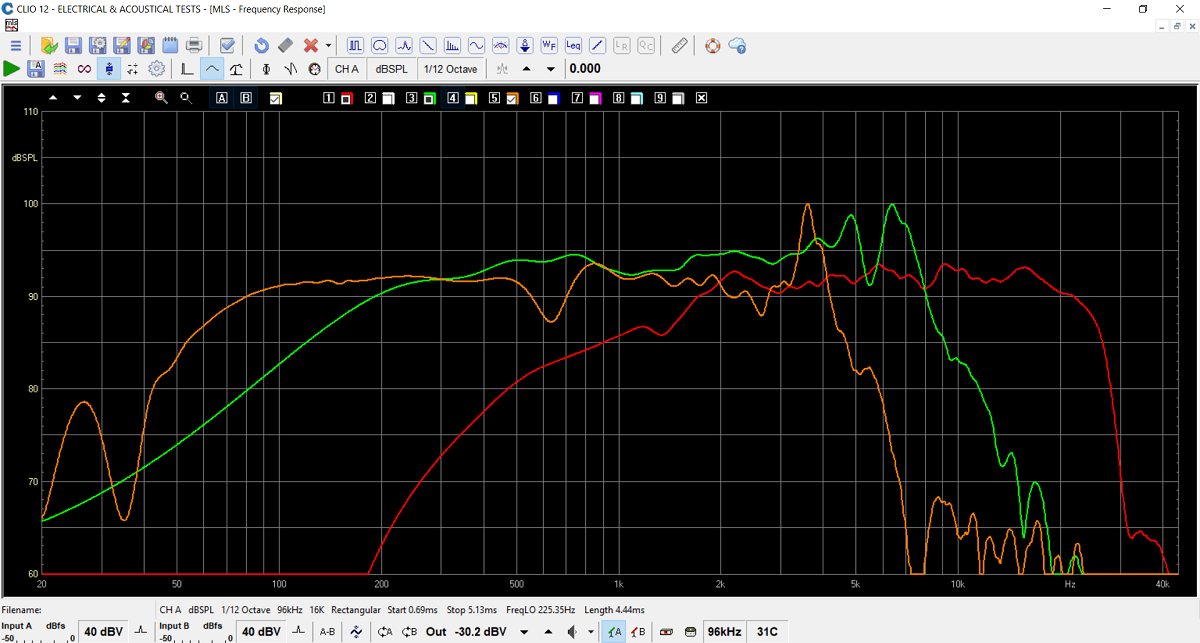
SPL of all drivers without crossover and normalised for 2.8V/1 meter.
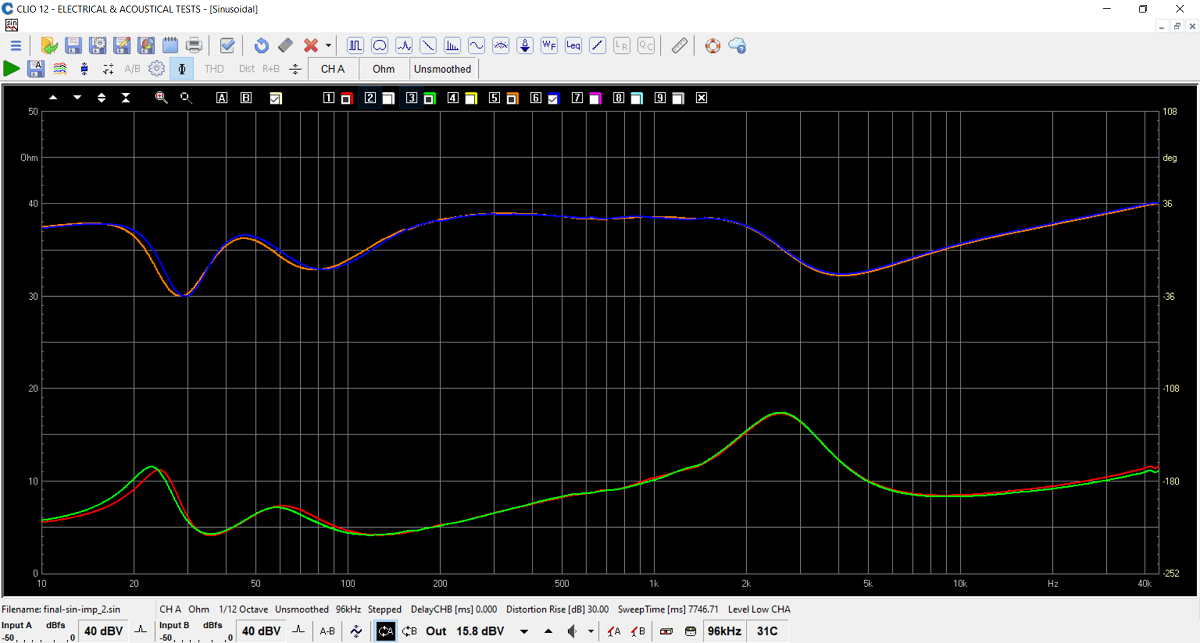
Impedance, red and green, of the final system, speaker #1 and #2.
Blue and orange: Electrical phase.
Overall and easy impedance of 8 Ohms with a minimum of 4 Ohms at 125 Hz.
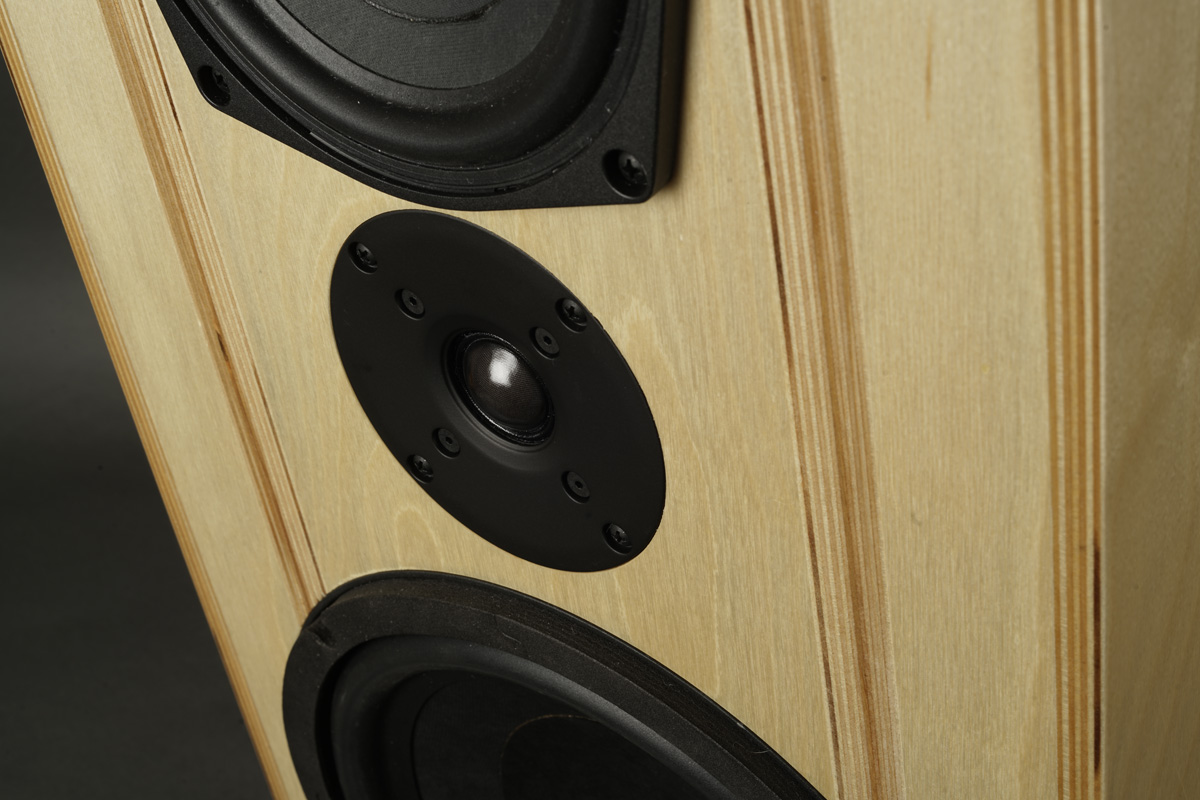
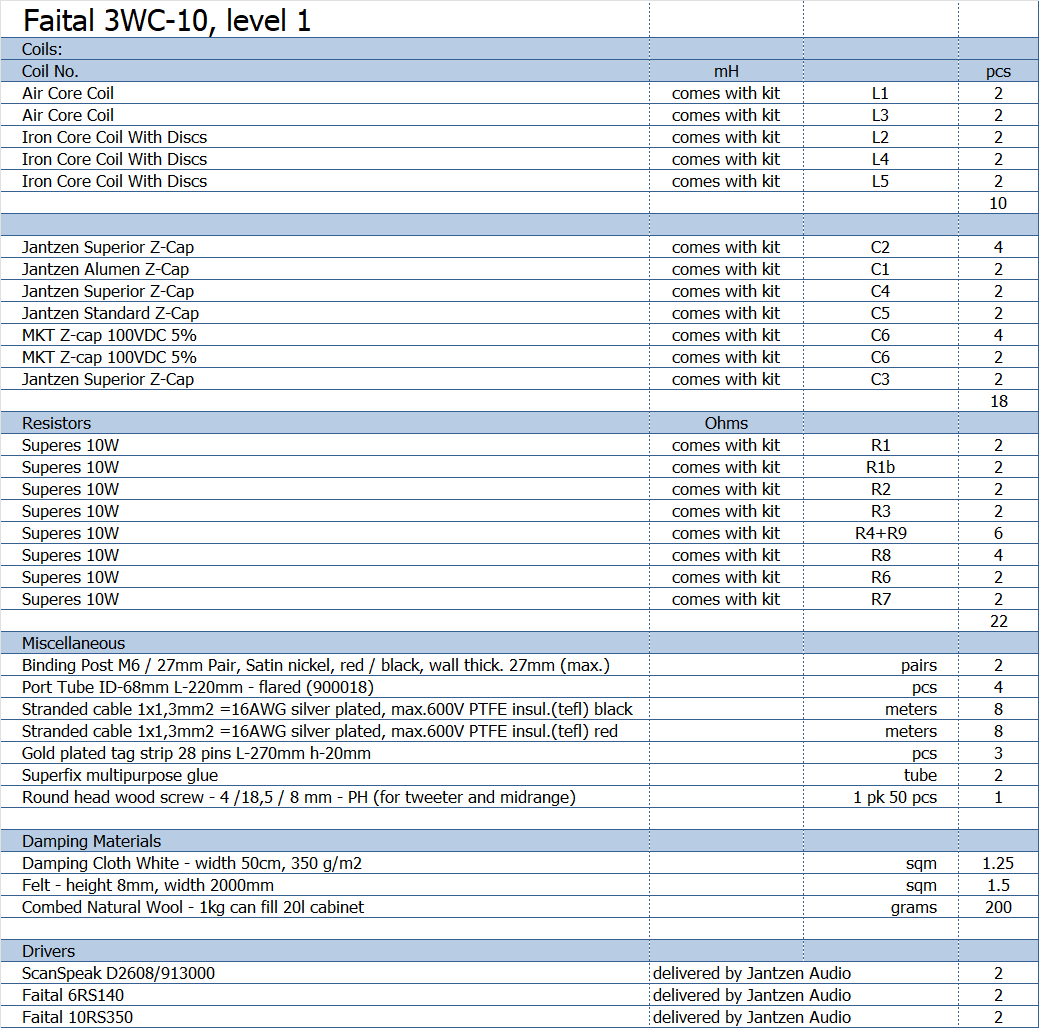
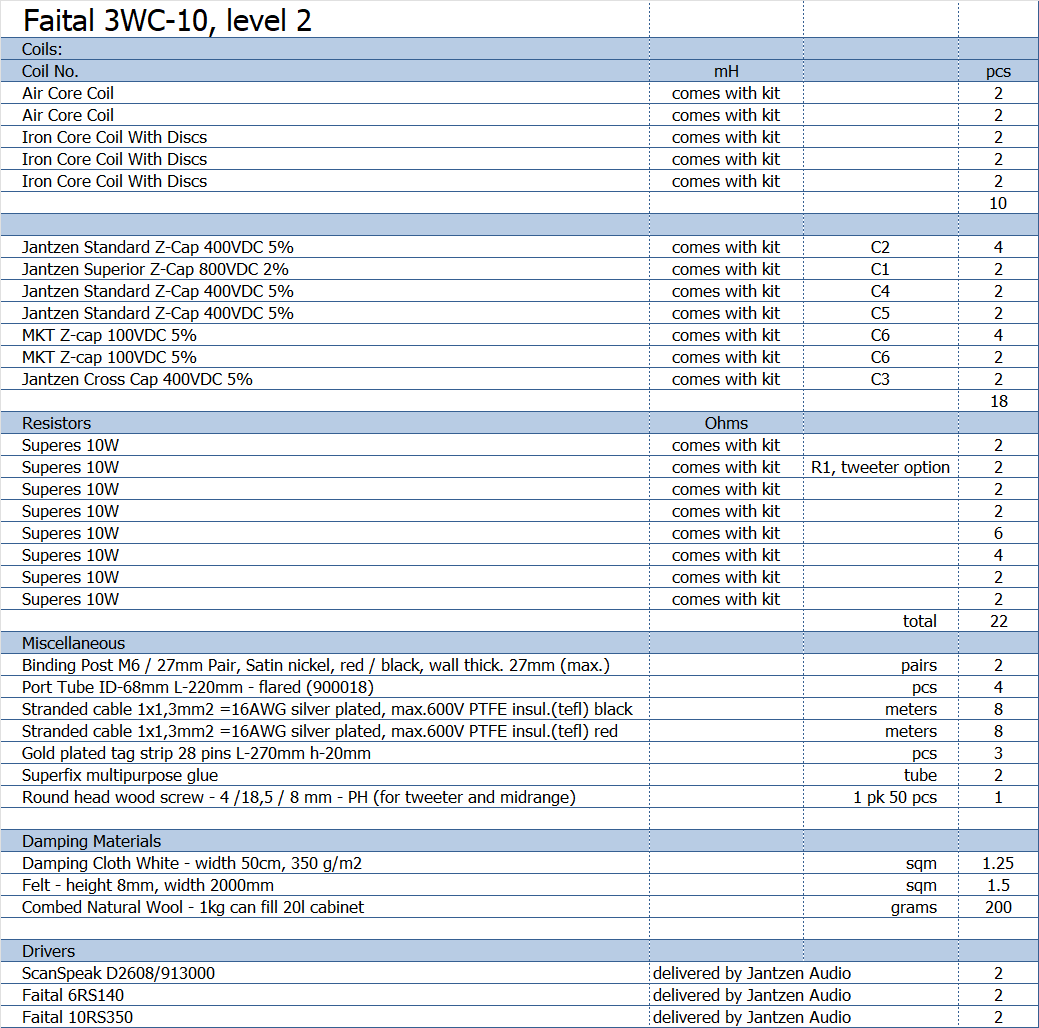
For level 2, air-core coil for L3, Superior-Z cap for tweeter and STANDARD-Z/CrossCap
for midrange.
All kit and component prices may be subject to
change and are always to be confirmed by Jantzen Audio Denmark.
Kits can be ordered with/without drivers or some of the drivers.
Download Kit Sale Presentations:

All technical questions to troels.gravesen@hotmail.com
All questions regarding purchase of kits, please mail Jantzen Audio at contact@jantzen-audio.com
CROSSOVER-LAYOUT
BACK TO INDEX
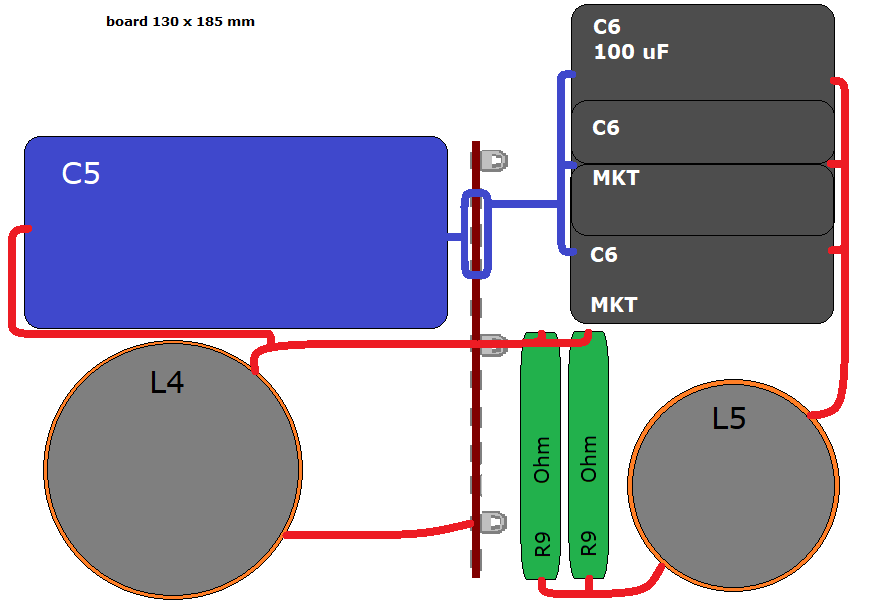
Crossover layout for bass section.
Since introduction, C6 has been replaced by better MKT-Z-Caps.
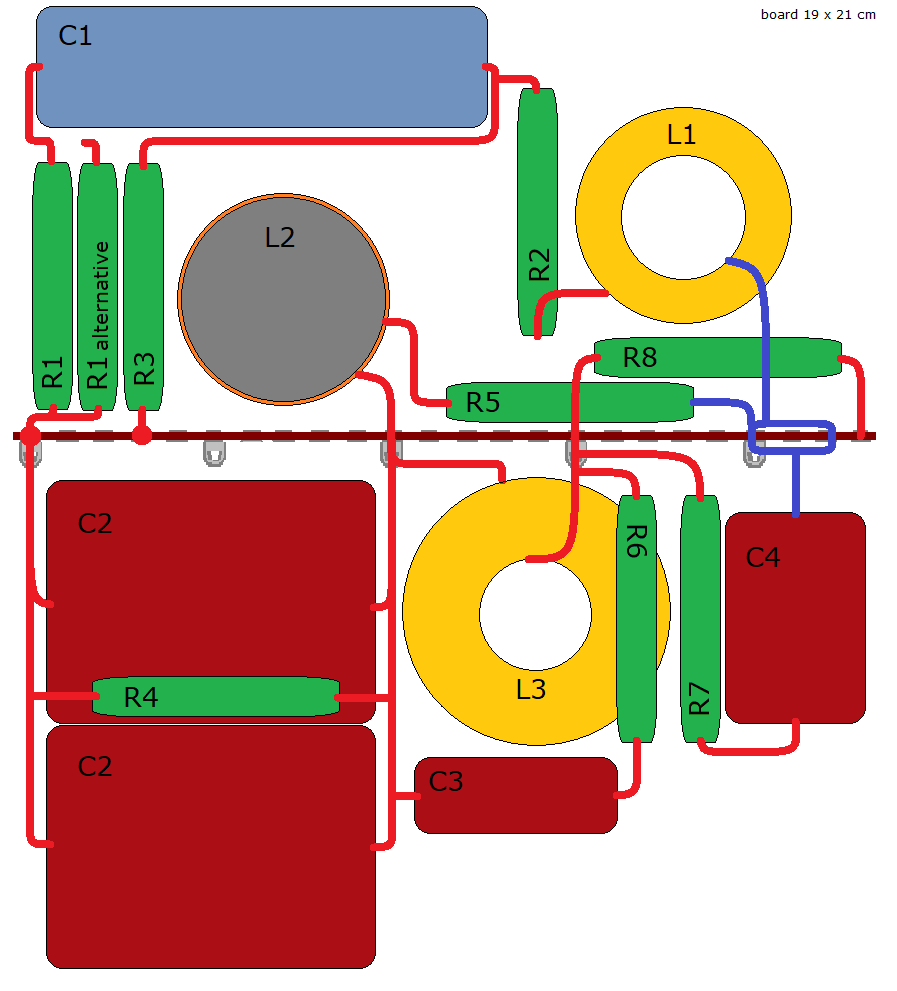
Crossover layout for midrange and tweeter.
I suggest mounting both R1 resistors. Connect only one to C1.
Highest value = lowest treble level.
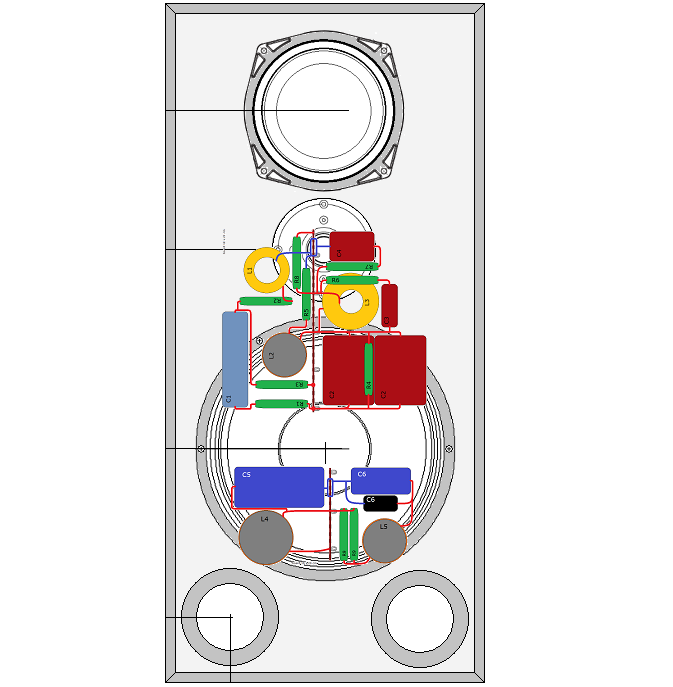
Placement of the crossover sections on rear panel.
SPEAKER WIRING

Here some photos of crossover construction. Hope it is helpful.
Also check this "tips" page to read more on crossover construction:
http://www.troelsgravesen.dk/tips.htm#CONSTRUCTION_OF_CROSSOVERS
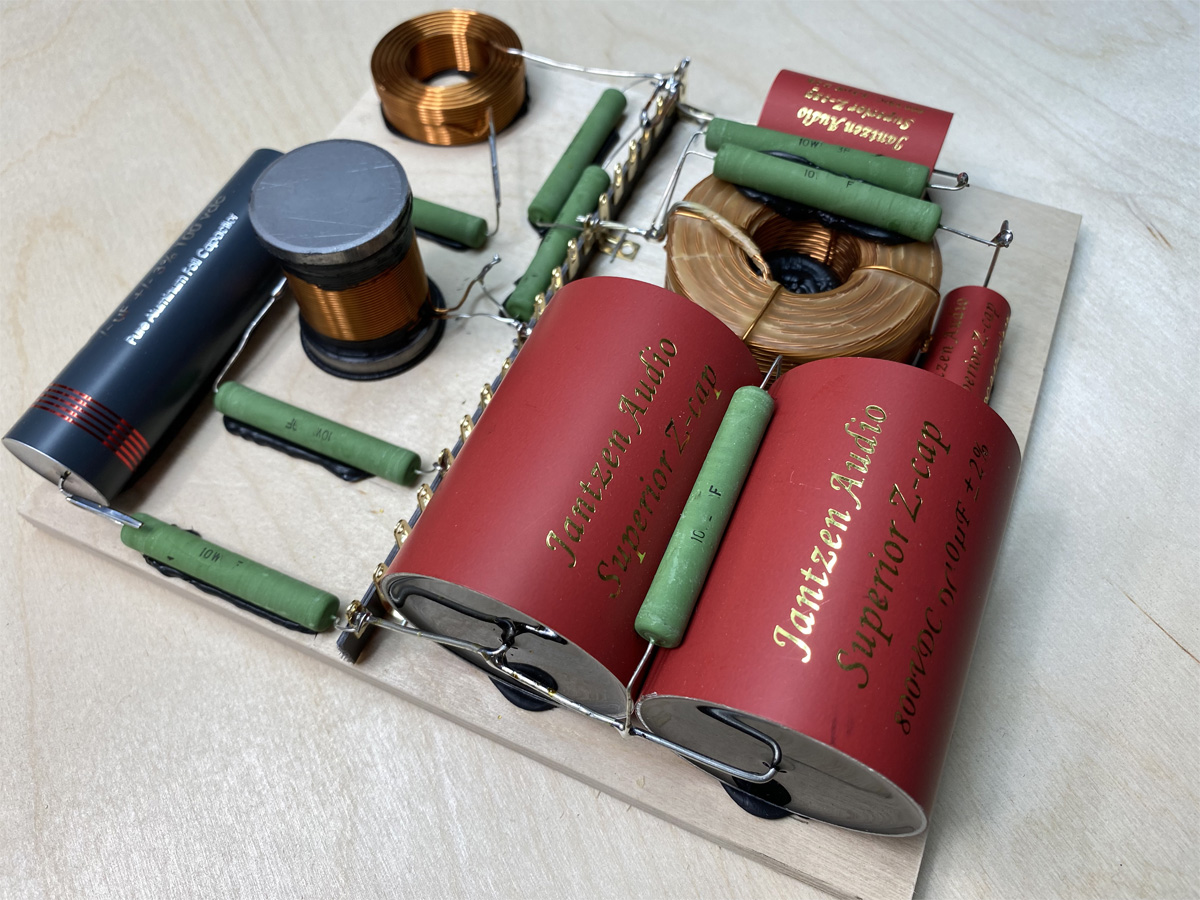
The finished mid-tweeter section.
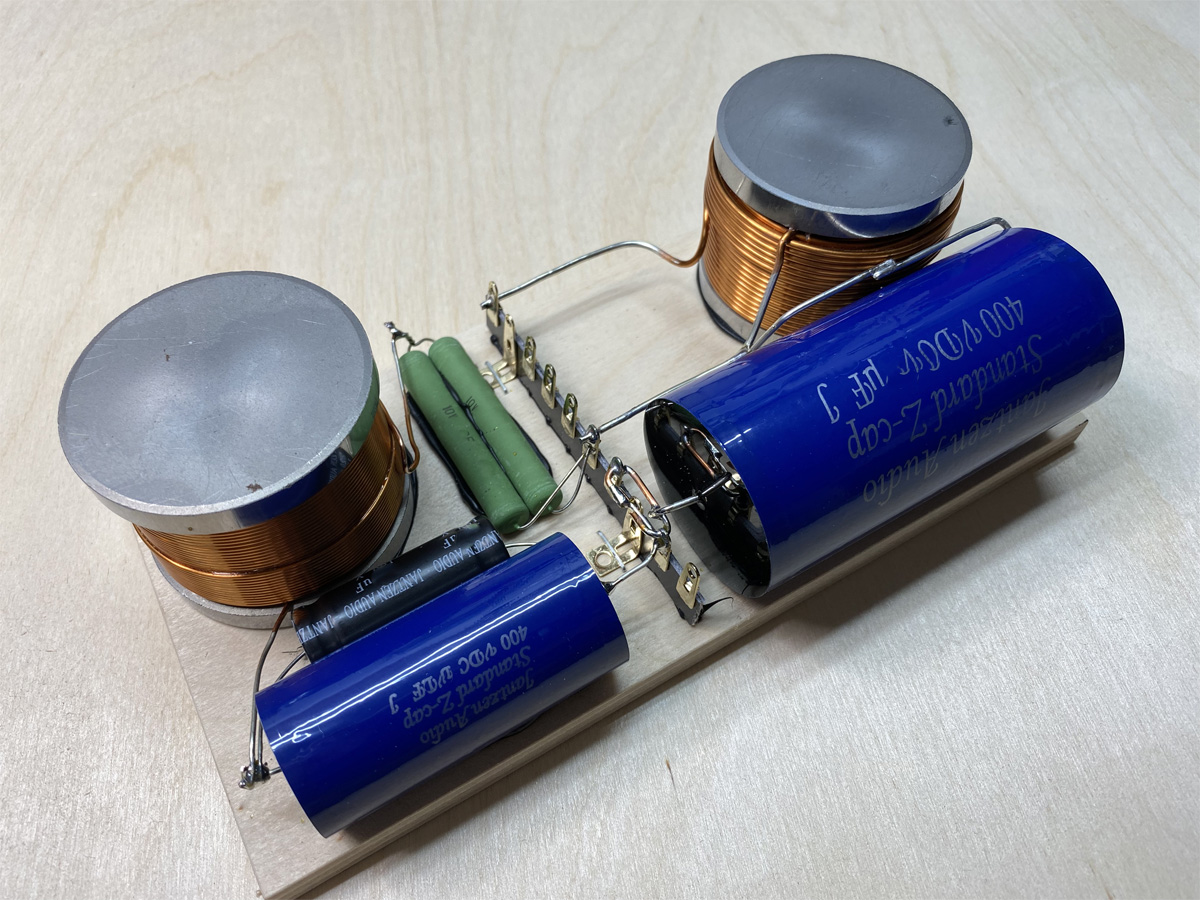
The finished bass section.
See changes to layout on drawing due to new MKT-Z-Caps.
Some pictures during crossover construction.
Check out the tips page for further info on crossover construction:
http://www.troelsgravesen.dk/tips.htm#CONSTRUCTION_OF_CROSSOVERS
BASS SECTION
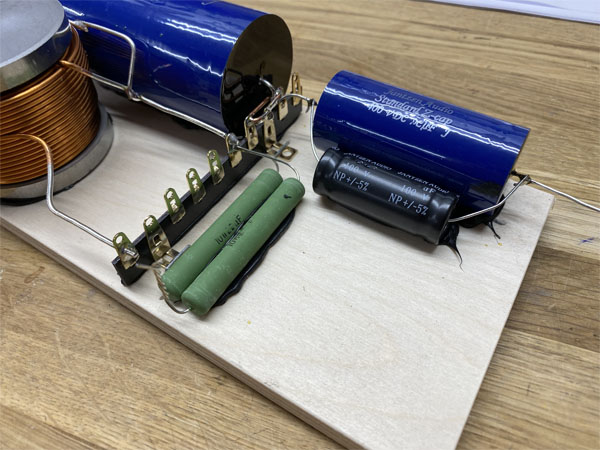
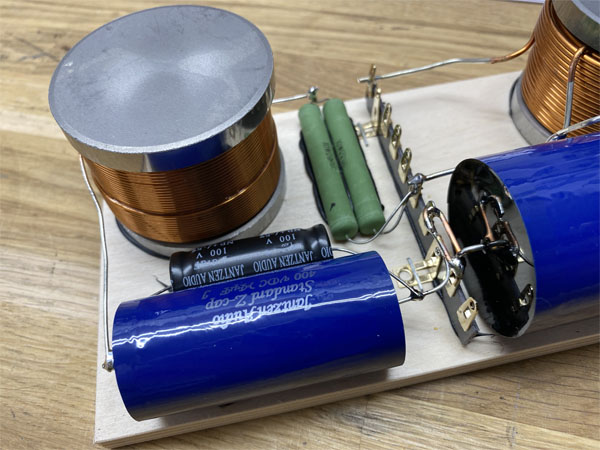
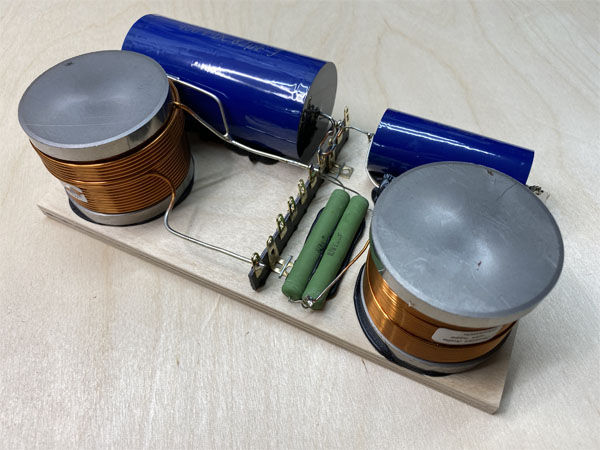
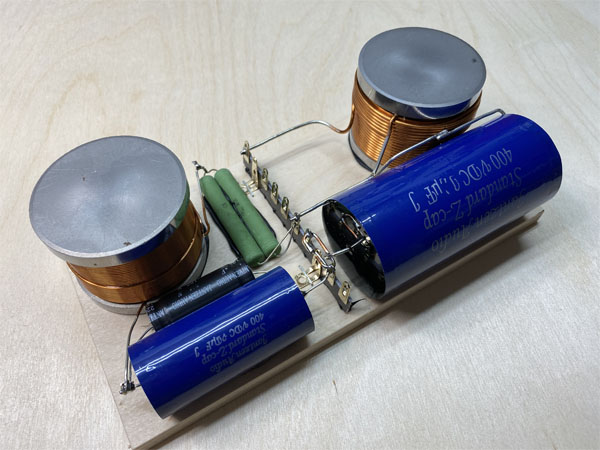
MID-TWEETER SECTION
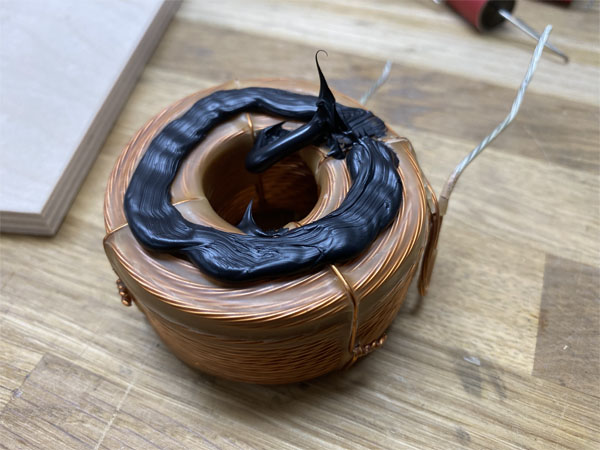
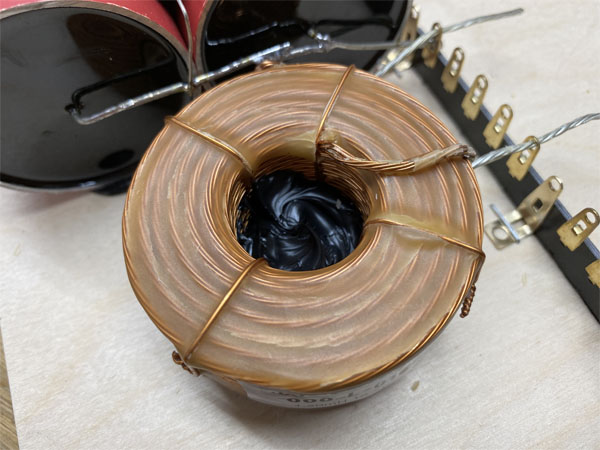
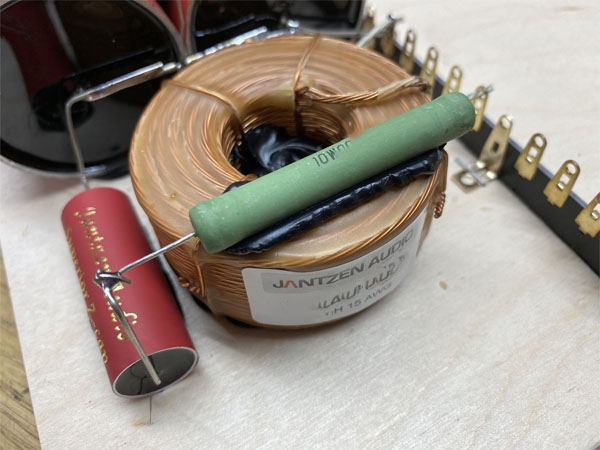
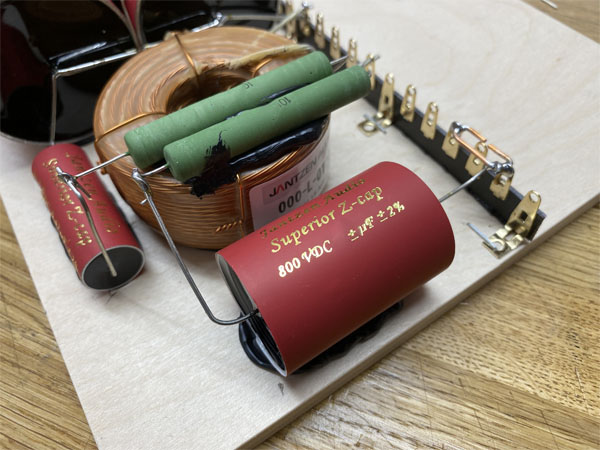
Note I moved R7 up next to R6 to reach the solder point.
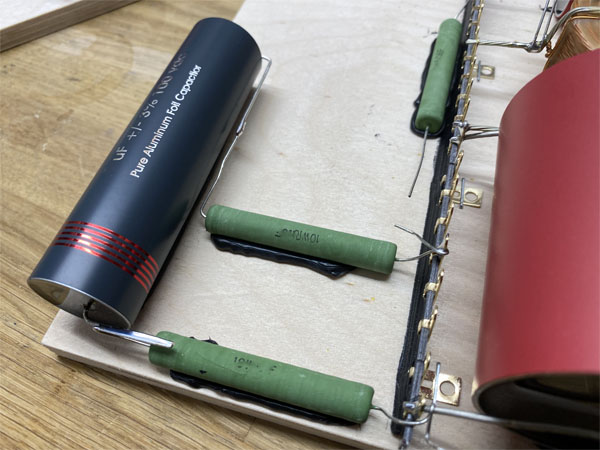
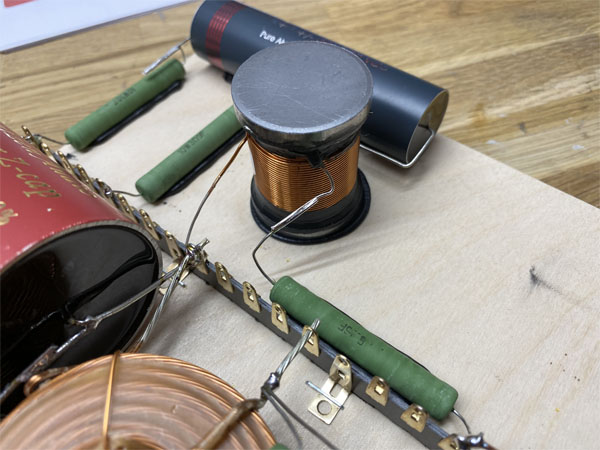
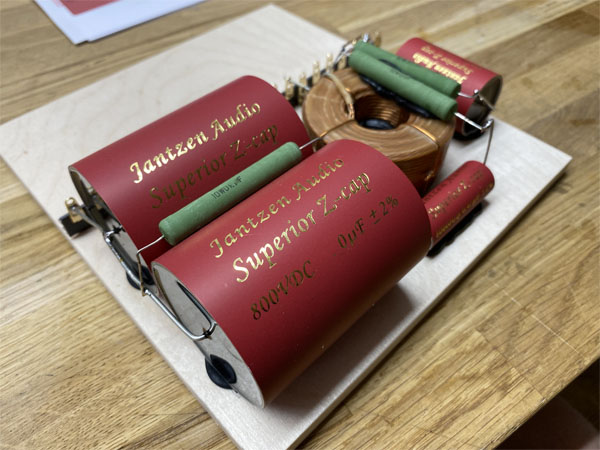
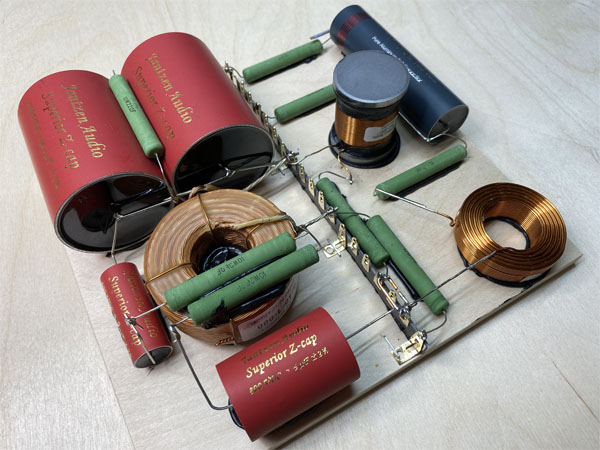
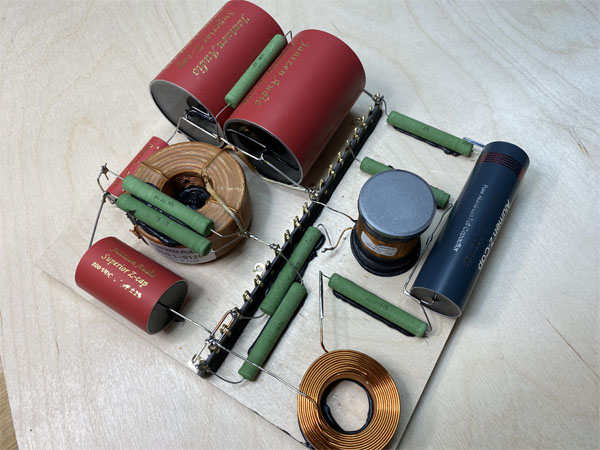
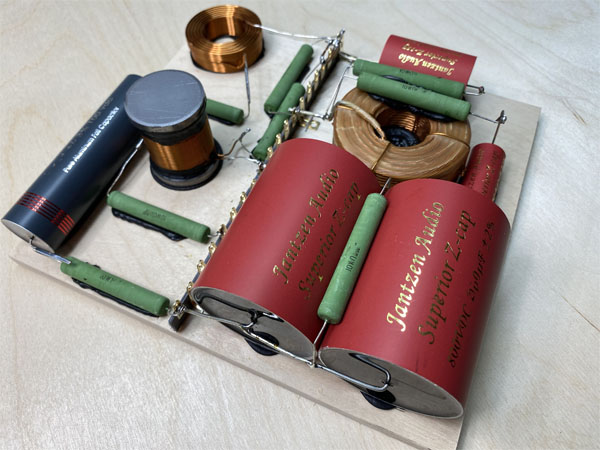
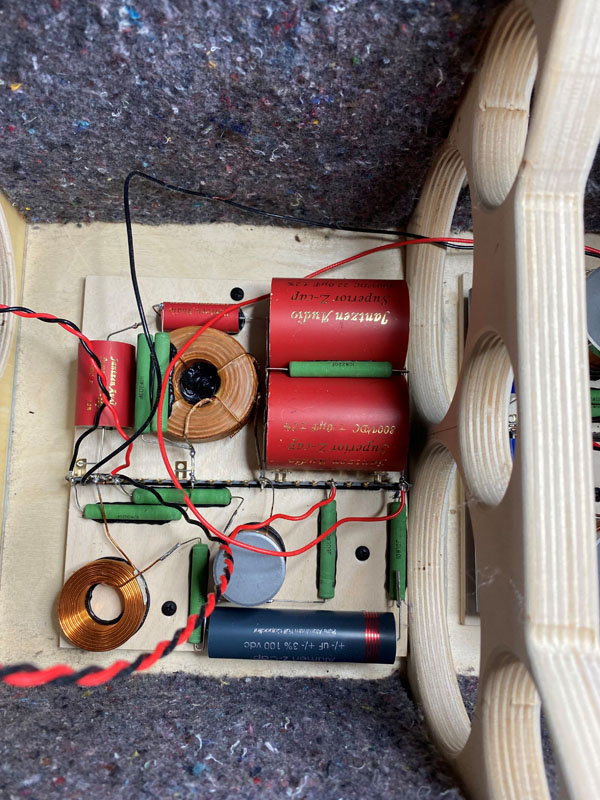
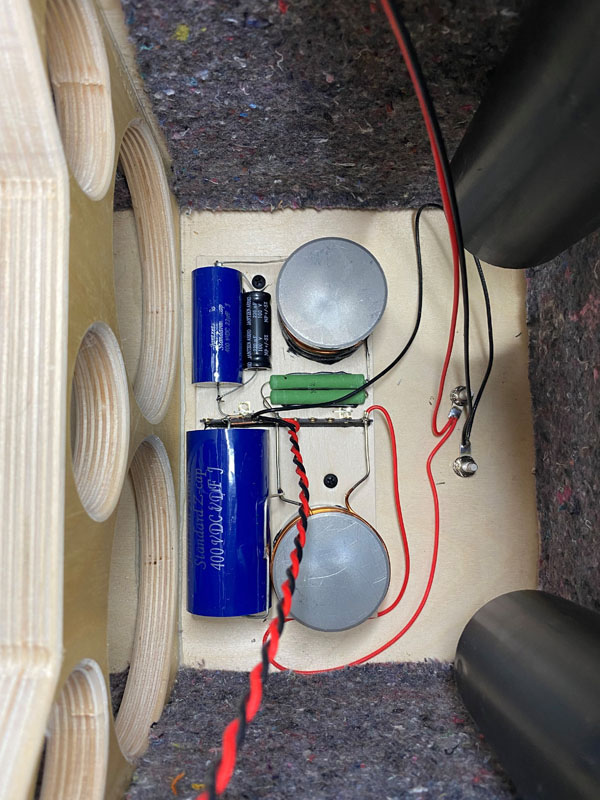
Left: Mid-tweeter section in place. Right: Bass section in place.
Connect the tweeter with positive polarity and connect the midrange
driver with negative polarity (!!!).
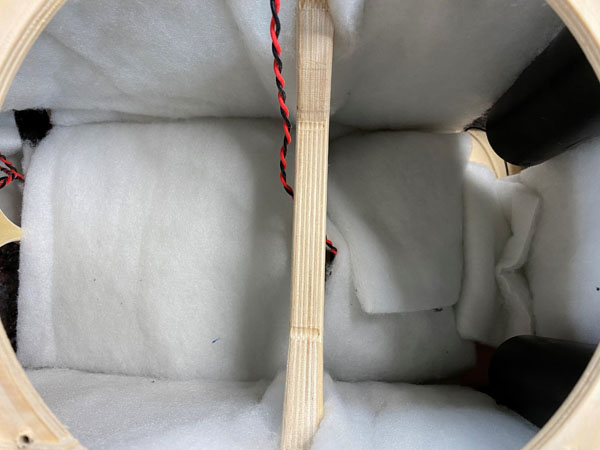
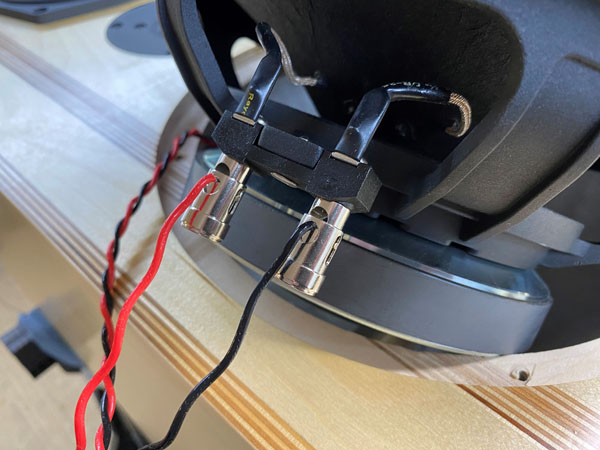
Cover with acoustilux as described above and connect bass driver - and
you're done.
Enjoy!
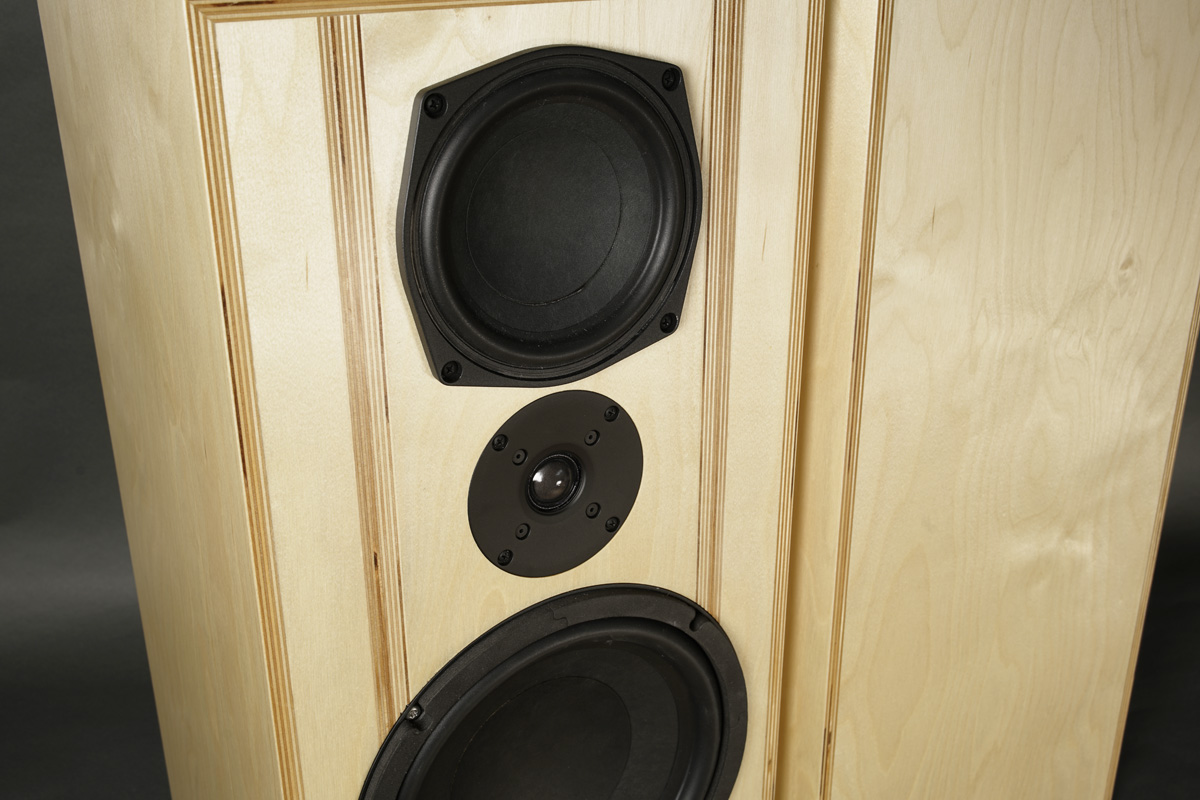
Beryllium dome version
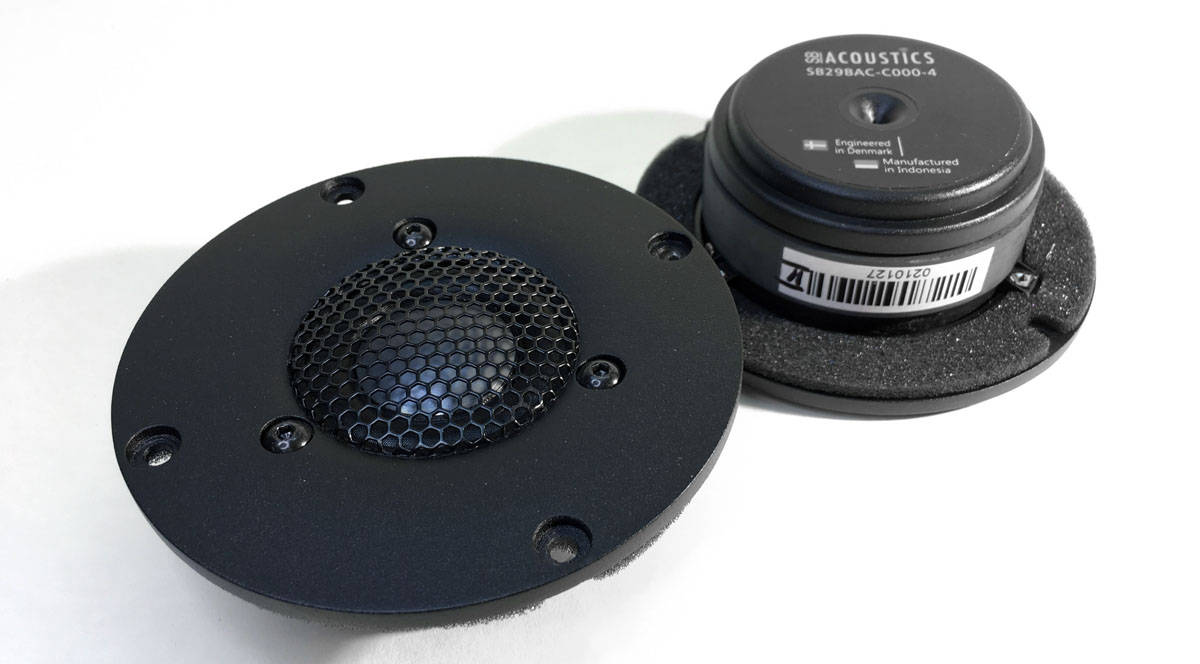
SBAcoustics SB29BAC-C000-4
Download specs here. Test here.
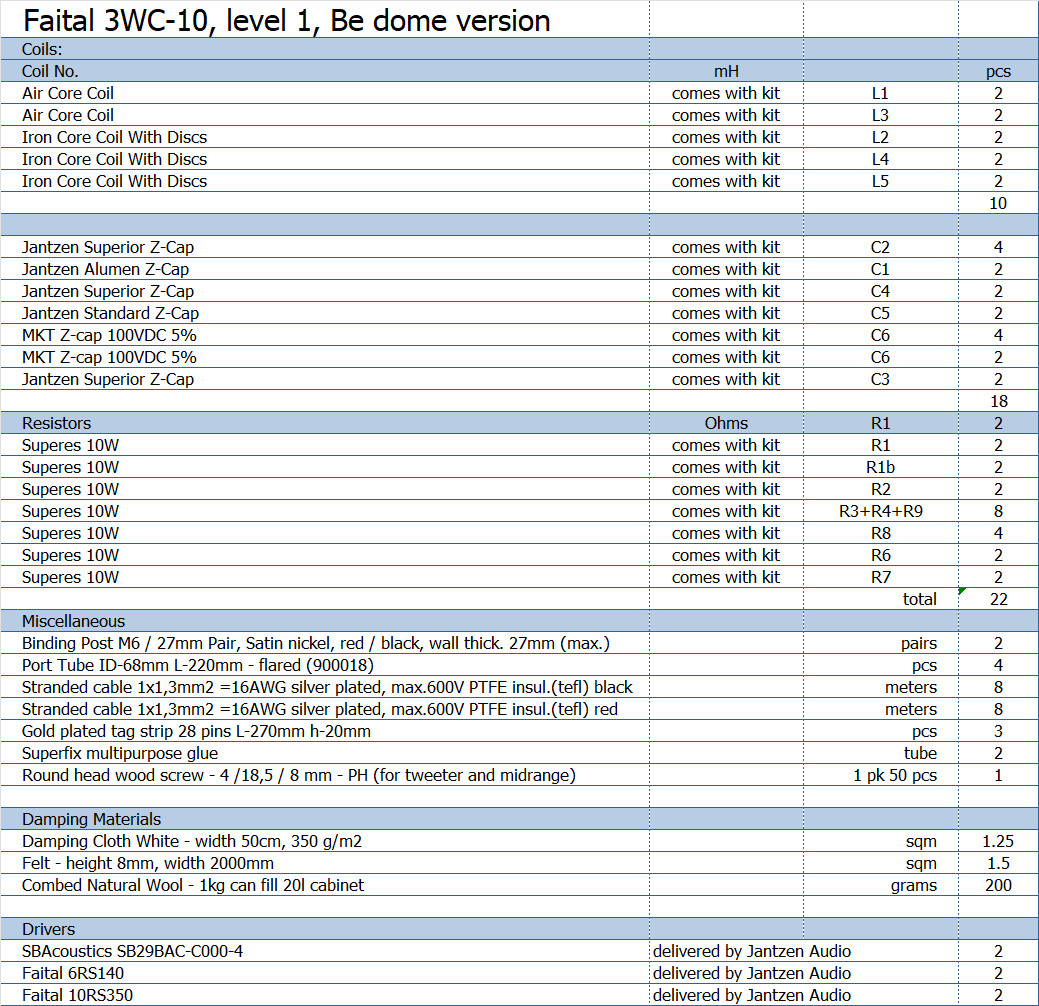
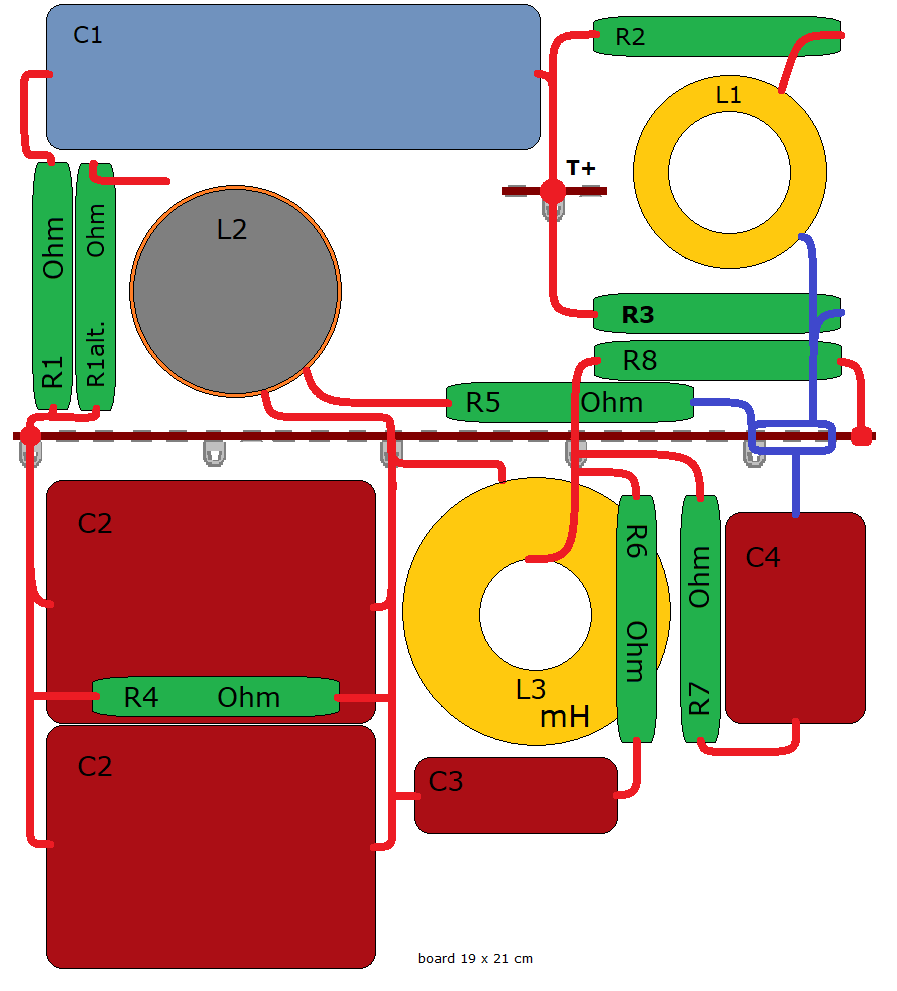
The crossover layout has changed a little for tweeter as we need R3 to connect to ground.
Connect tweeter PLUS to T+.
Connect only one of R1 to C1. Highest value = lowest treble. Find out what you like the best!
